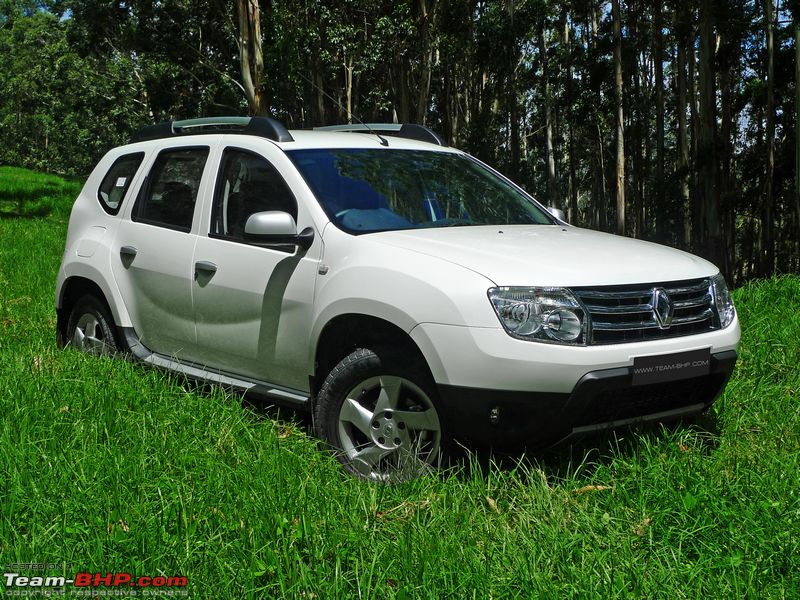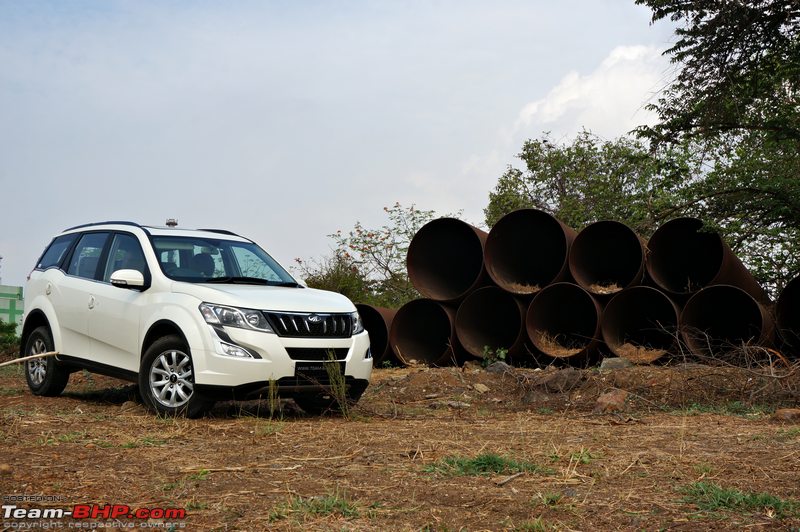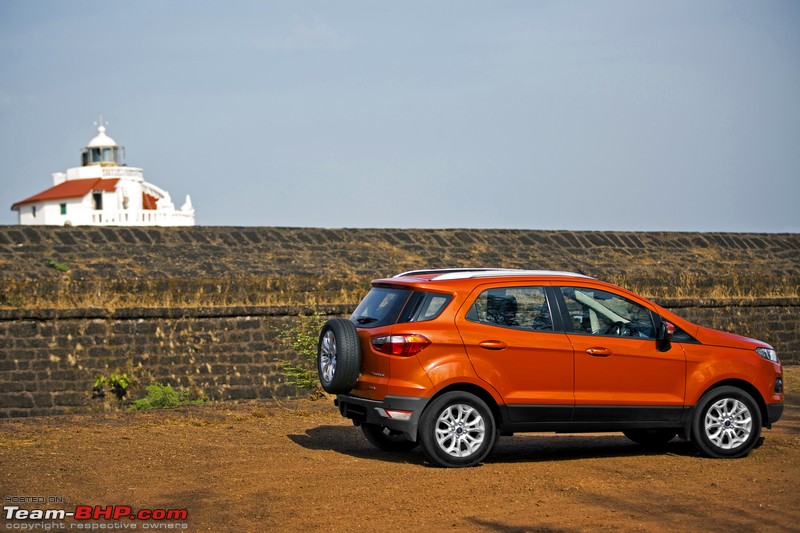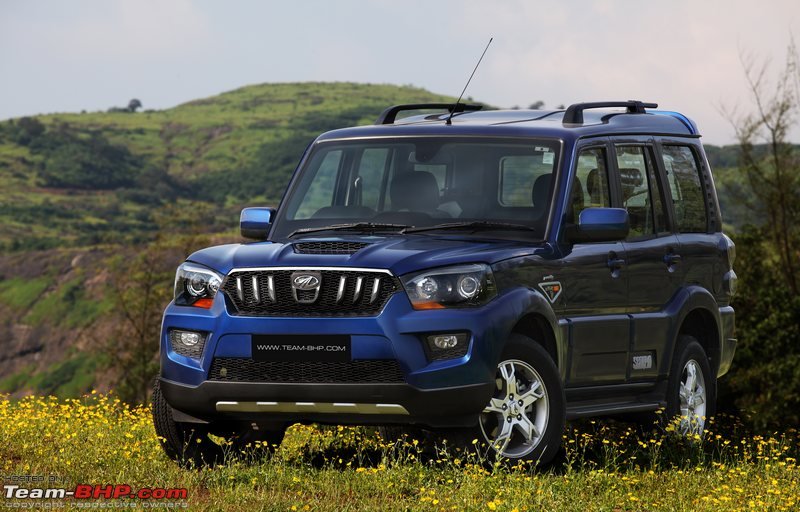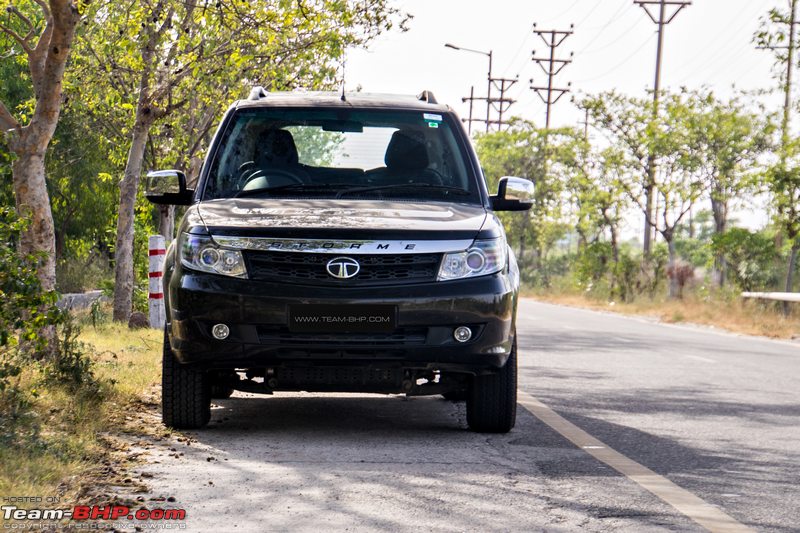| |||||||
| Search Forums |
| Advanced Search |
| Go to Page... |
 |
| Search this Thread |  3,900,801 views |
| | #1 |
| Team-BHP Support  Join Date: Dec 2004 Location: MH-12
Posts: 8,443
Thanked: 13,956 Times
| Review: Hyundai Creta (1st-gen) The Hyundai Creta has been launched in India at a price of between Rs. 8.59 - 13.60 lakhs (ex-Delhi). What you’ll like: • An all-rounded urban SUV. Perfect size for Indian cities...good looking too! • Well packaged interiors offer sufficient legroom & headroom • Excellent 1.6L petrol & diesel engines. Awesome refinement levels • Automatic + diesel combination available. 6-speed AT is very smooth • Balanced suspension offers comfortable ride quality & neutral handling • Hyundai's reliability, competent after-sales & 3 year unlimited kms warranty • Equipment such as 6 airbags, ESP, touchscreen ICE, hill-start assist, reversing camera & more What you won’t: • Premium pricing! Most BHPians feel that it's overpriced by Rs. 1 - 1.5 lakhs • Several missing features, big & small. Disappointing at this price point • Petrol MT & Diesel AT are unavailable in the SX(O) trim • Rear seat is more suitable for 2 adults, not 3 • No AWD capability like the Duster & XUV500. Adventure tourers, look elsewhere • Some competitors offer you 3 seat rows for the same money • Waiting periods have already begun. Over 6 months in many cities The Petrol AT: • Link to Review The 2018 Facelift: • Link to Review Last edited by GTO : 4th July 2018 at 11:21. Reason: Adding link to 2018 Facelift |
| |  (72)
Thanks (72)
Thanks
 |
| The following 72 BHPians Thank moralfibre for this useful post: | 9thsphinx, aah78, Aditya, Aficionados, AkMar, amit_zen, AutoIndian, benbsb29, countdredd, ecosport rules, fusionbang, gpa, Grand Drive, groom, gschandra, GTO, guptashish, harry10, Hatari, hemanth.anand, InControl, Jaggu, jeetaman, joednazareth, KPS, mh09ad5578, mi2n, MindOnWheels, murajith, Nagendra_blr, naveen.raju, noopster, pbishayee, pgginish, PGNarain, Rajeevraj, RavenAvi, rednikhil, redrage, rev_rohit, riturajsharma19, RSR, S2!!!, samabhi, sandeepmohan, scopriobharath, SDP, sdp1975, Sheel, shipnil, sidhu_hs, Simhi, SmartCat, SnS_12, SoumenD, spsam, super.cars, swiftnfurious, Technocrat, The Rationalist, theexperthand, theredliner, Turbo_asd, Tushar, vb-saan, vibbs, Vid6639, VijayAnand1, vikred, vinayrathore, VIPER_SRT, yosbert |
| |
| | #2 |
| Team-BHP Support  Join Date: Dec 2004 Location: MH-12
Posts: 8,443
Thanked: 13,956 Times
| re: Review: Hyundai Creta (1st-gen) 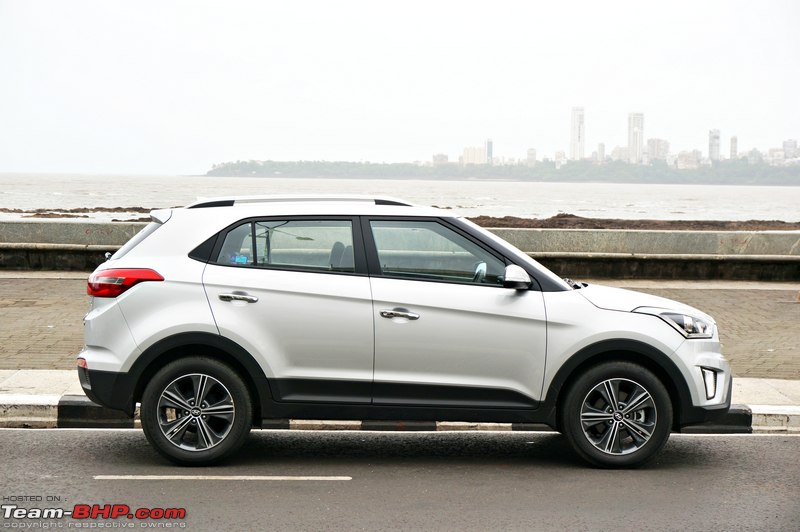 It's shocking how the 6 biggest Indian car manufacturers missed the million-rupee monocoque SUV craze of the country. This is especially so for Hyundai & Maruti who usually have their finger on the pulse of the market. Many have tried to take a shortcut by adding plastic cladding to hatchbacks & raising their stance with a jacked up suspension. However, the pseudo SUVs found few takers, and models like the VW Cross Polo, Fiat Avventura, Toyota Etios Cross and Hyundai i20 Active are far from being best-sellers. On the other hand, the Ford EcoSport and Renault Duster (in particular) have been enjoying success, due to their monopoly in the urban SUV segment. It was clear that customers were putting their money on products that actually looked like SUVs, as opposed to inflated hatchbacks. Hyundai looked at its international product range and picked up the Chinese ix25 as a worthy contender to battle in this segment. There was one small change though: the ix25 was rebadged as the Creta! You’ll agree that the name is awkward and Hyundai could have definitely come up with something better. We believe this name change has to do with nomenclature updates at the global level. The ix series is already being dropped internationally. For instance, the 3rd-gen Hyundai Tucson has regained the moniker, after being christened as the ix35 in its 2nd-generation. The Creta is a very important product for the Koreans, especially because Maruti remains weak in the 10+ lakh segment and the S-Cross is unlikely to change that. Profit margins on SUVs are fatter than mass market hatchbacks & sedans too. The Creta will be manufactured in India and exported globally (they haven't specified exactly which countries yet). The Indian arm has pumped in 1,000 crore rupees on the Creta, and it is the company's 10th model on sale. The Creta fills up a void in the 10 - 20 lakh SUV category rather well. For some, the EcoSport is too small and the Duster too old and crude. There's also the case of the extremely competent XUV500 which is priced in the vicinity. It's much bigger, gets 3 rows of seats, superb equipment levels, a powerful 2.2L engine and benefits from Mahindra's improved engineering skills. XUV500 owners are generally a happy lot too. Not everyone wants to buy an XUV500 though, due to its sheer size, the Mahindra brand and hit-or-miss dealer network. The Creta is backed by Hyundai's marketing muscle, reputation for quality & excellent after-sales service. In that sense, it carries a good differentiator as an all-round package. The Creta is a fairly neutral product with no real deal-breaker. On the pricing front, the Creta is definitely placed at a premium, and a lot of BHPians feel that it's overpriced by 1 to 1.5 lakh rupees. It costs about 1 lakh more than the Duster which was premium priced to begin with (actual difference is even more because the Duster has discount offers). That said, the Creta is a far more contemporary product, has additional features, more refinement & quality, superior safety kit etc. While on the topic of pricing, we can't help but bring the Verna into the picture. Other than the increased ground clearance, the Creta has no real advantage over the Verna. It's still priced higher; take the top-end petrols and the difference is a lakh, despite the cheaper Verna giving you 6 airbags (Creta petrol = 2 airbags)! With the 1.6L diesels, the difference between the top-end Verna & Creta (both with 6 airbags) is a whopping 2 lakh rupees! The Creta is from the monocoque breed of SUVs (like the Duster & EcoSport) and not the rugged body on frame type (like the Safari & Scorpio). It's sold with 3 engine options, all shared with the Verna - a 1.6L petrol and two diesels (1.4L & 1.6L). All 3 engines are mated to 6-speed gearboxes. The 1.4L diesel is only available in the starting three variants, while the 1.6L diesel is sold in the top three variants. Hyundai's trump card will be the 1.6L diesel AT. The XUV500 AT remains indefinitely delayed and Ford offers the EcoSport AT only with a 1.5L petrol. Premium customers love slush-boxes. Had Mahindra not put the Scorpio AT on sale immediately after the Hyundai's launch, the Creta would have been the sole diesel automatic SUV this side of the Rs. 25 lakh SsangYong Rexton and Mitsubishi Pajero Sport. Though the Scorpio and Creta aren't direct competitors in many ways - big body on frame vs soft urban SUV - you now have two automatic options in the 10 - 20 lakh space. There's another USP not many have noticed, yet it's a strong one. At a time when petrol cars are making a comeback, the Creta offers a smooth & capable 1.6L petrol motor. The Duster has a lacklustre petrol engine while the XUV500, Scorpio, Safari and gang don't offer a petrol at all (a good thing considering their weight). The EcoSport gets an awesome 1.0L EcoBoost motor, but the vehicle is a size smaller than the Creta. As things stand today, if you want a midsize petrol SUV with a nice engine & feature list, the Creta is your only choice. On the other hand, I'm perplexed as to why Hyundai won't offer a petrol AT. The company already sells this 1.6L petrol with an AT in other cars and I'm hopeful of a correction in product strategy here. If you have the engine & transmission ready anyway, why not let the customer decide whether it deserves a place in the showroom or not? Additionally, we have a problem with Hyundai not selling the petrol in the fully-loaded SX(O) variant. That was just a silly decision! 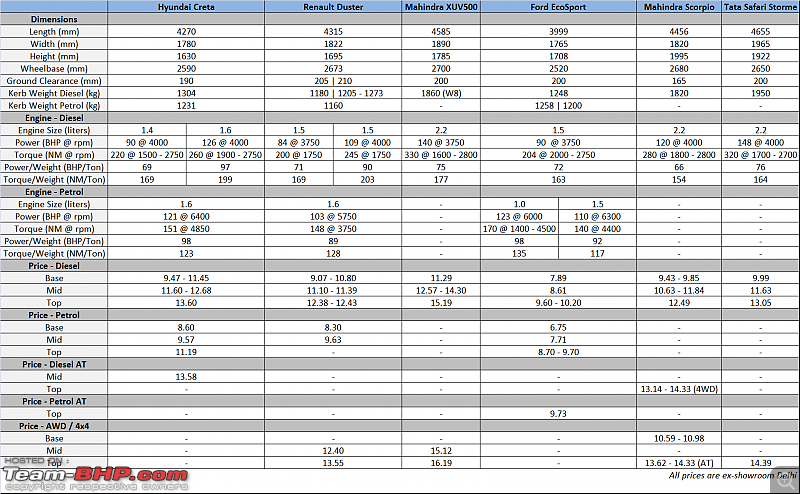 Size wise, the Creta is more comparable to the Duster than the sub-4 meter EcoSport. At 4,270 mm, the Creta's length is 45 mm lesser than the Duster's. The Creta's width comes in at 1,780 mm and its height stands at 1,630 mm. This means the Duster is 42 mm wider and 65 mm taller than the Creta. At 2,590 mm, the Creta's wheelbase too is 83 mm shorter than the Duster's. Just like the Renault, the Hyundai isn't too big nor too small. In fact, it's perfectly sized for an urban SUV. For those cross-shopping with C+ segment sedans, the Creta has the perfect footprint. On the other hand, if you desire a big & brash SUV, shop elsewhere. The Creta simply lacks the butch presence of SUVs like the XUV500 & Safari Storme. Design wise, the Creta certainly comes across as a shrunken Santa Fe. It wears Hyundai's new Fluidic 2.0 design language, with a big Santa Fe-like triple slat grille dominating the front end, along with Santa Fe-like headlamps housing projectors, LED positioning lamps & static bending lights (like in the XUV500). That flat bonnet is quite large for an SUV of this size. The shiny black A-pillars look stylish (à la Maruti Swift) while the bottom part of the body has black cladding all around. At the rear, the smart horizontally laid-out tail lamps blend well with the overall design. The only thing I found odd & out of place was that ugly chrome garnish above the rear number plate. It doesn't gel with the SUV at all. The top SX(O) variant wears 215/60 tyres on 17" diamond cut alloys, while the lower variants ride on 205/65 R16 rubber. Fit and finish are top notch, with Hyundai remaining consistent in delivering quality products. All body panels are tightly aligned with no odd panel gap that stands out. Paint quality is good (not VW good though). The doors shut just like other modern day premium Hyundais (Elite i20, Verna), but don't carry that solid European "thud". The bonnet feels heavy enough, although the tailgate feels light. The exterior plastics are made from well-chosen materials and get a neat finish. There aren't any rough edges that feel out of place on the car. Hyundai's communications increasingly stressed on the Creta’s safety levels. It has an ultra-high tensile steel body structure with protection in all directions from 'ring-shaped frames'. The pillars (including the center pillar), side frames and bottom are positioned in a ring-like layout, all connected. Hyundai says this ring-structure brings a significant increase in body stiffness. In addition to the ribbed roof, there are 5 cross members that provide additional reinforcement and protection. In the Chinese NCAP tests, the ix25 scored the full 5 stars for safety. ABS is standard across the range in India. The impressive safety pack of the top variant includes 6 airbags, traction control, ESP and hill-start assist. The Chinese version has an AWD system mated to a petrol (no diesel engine there). Unfortunately, the Indian Creta doesn't get the AWD option. Period. If you like to play in the mud or tour the unexplored corners of India, check out the robust Duster & XUV500 AWDs instead. If there is one area in which Hyundai has messed up - and I mean royally messed up - it's the features. What has traditionally been a Hyundai strength is strangely a weak spot in such an important product. As things stand today, Hyundai can give you segment-leading equipment levels in a 6 lakh Grand i10 & 8 lakh Elite i20, but it's unable to in the 15 lakh Creta. Allow me to touch upon some of the goof-ups: • Rear disc brakes were offered on the i20 & Verna at one time. Today, even the premium-priced Creta makes do with lame drum brakes at the back. • No auto-headlamps, steering reach adjustment or cooled glovebox, all of which the substantially cheaper i20 gets. The Elite i20 also has 2 more speakers & an electrochromatic mirror. In the Creta, you have to manually select day / night mode on the IRVM. How irritating. • Walk up to the Elite i20 and its mirrors fold out (sensing the smartkey). Lock the i20 and the ORVMs fold in. Creta? Nope, no auto-folding mirrors. • You'll pay 1.5 million on-the-road for the Creta petrol or diesel automatic SX+. At that price, you get merely 2 airbags. Your doors won't auto-lock as you drive away, and the steering feels hard because it isn't leather-wrapped!! Your seatbelts aren't height-adjustable and neither can you adjust the meter console's illumination level. Look up and you'll see fixed grab handles staring back at you. • Features we'd expect for this $$$: An adjustable driver armrest, FE & DTE readings on the MID, vanity lights (sunvisor), illuminated power window buttons, cruise control, sunroof, gas struts to hold the bonnet up etc. All absent. • Oddly, the automatic variant gets a 60:40 splitting rear seat & ISOFIX child seat mounts, but the top-end SX(O) MT doesn't. The SX(O) owner buys a higher variant with less kit? • Whoever decided that the Petrol MT & Diesel AT shouldn't be made available in the top-end SX(O) trim really didn't have a clue about market trends. Hyundai should realise that its reputation is built on the overall ownership experience; strong feature lists are a big contributor to the 'feel good' factor. Honda got all stingy with features and learned its lessons the hard way. We hope Hyundai wakes up and corrects this error in judgement. Fact is, cars like the EcoSport on one side and the XUV500 on the other own the Creta in terms of features & equipment. The XUV500's new W10 variant even offers a sunroof & powered driver's seat! The Creta looks more like a shrunken Santa Fe than an overgrown hatchback. The SUV carries Hyundai’s Fluidic 2.0 design language, which is more mature (not loud). The front end is especially handsome. Headlamps look smart and you know that Indians will love the 3-slat chrome grille:  Clean rear. The only bit we don't like is that chrome strip which seems like an afterthought. A tail-mounted spare wheel would have enhanced its 'SUV' styling:  Looks very contemporary. It’s a well-sized SUV for urban dwellers. A distinct beltline gives the side some character. Notice how the roof drops at the rear:  Looks sharp from some angles. Overall, a neutral design that will please all and offend none. The body has a drag coefficient of 0.36: 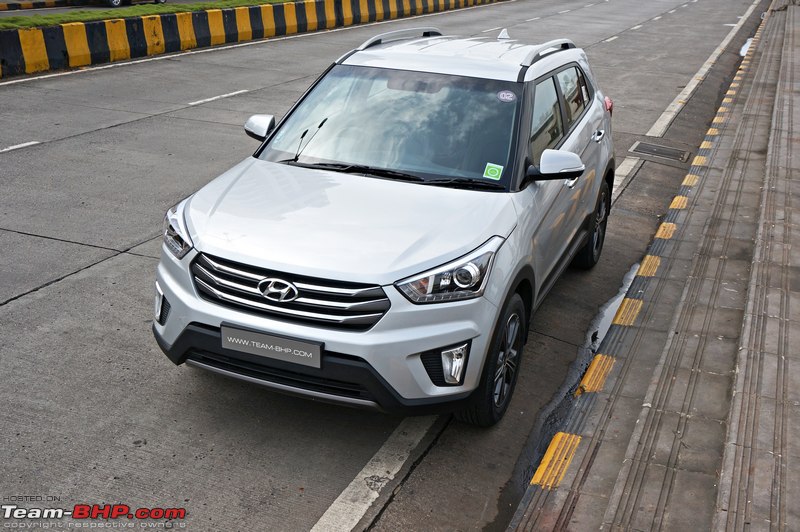 The bumper goes more than halfway up at the rear! The rising beltline makes the rear end appear taller at the same time. The Creta looks great in colours like white, silver & red. Black, for example, hides the lines & contrast cladding:  Santa Fe-like projector headlamps. In this image, the LED pilot lamps are on. They look nice at night, but you can't use them as DRLs as they're hardly visible during the day:  The static cornering lights in action. They activate in the direction of steering wheel inputs and are quite effective:  The headlamp cluster when lit up:  Projectors have good coverage in low beam. Powerful high beam offers great illumination for those night-time highway runs:  The wide triple-slat chrome grille takes inspiration from big brother, the Santa Fe:  Fake plastic skid plates finished in matt silver. They add to the SUV'ish character:  Neat looking, vertically-placed foglamps: 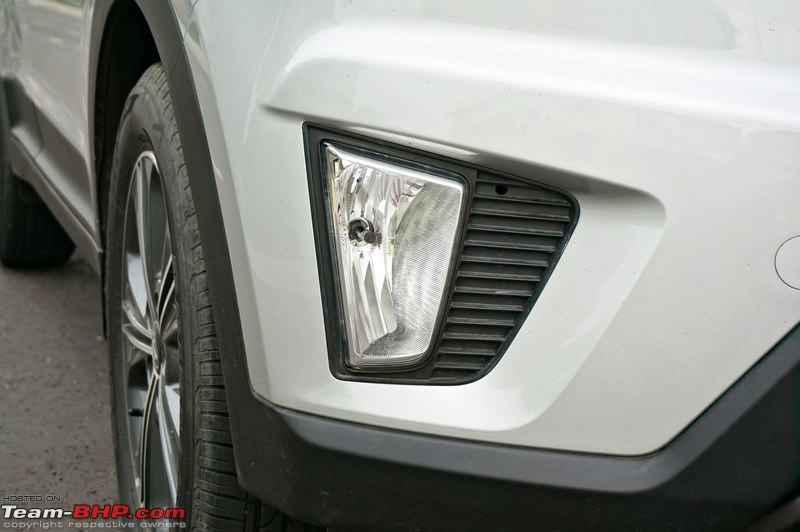 Bonnet is on the larger side:  See how the headlight bulges out of the body line. Also visible in this pic is the bonnet's unique side cut: 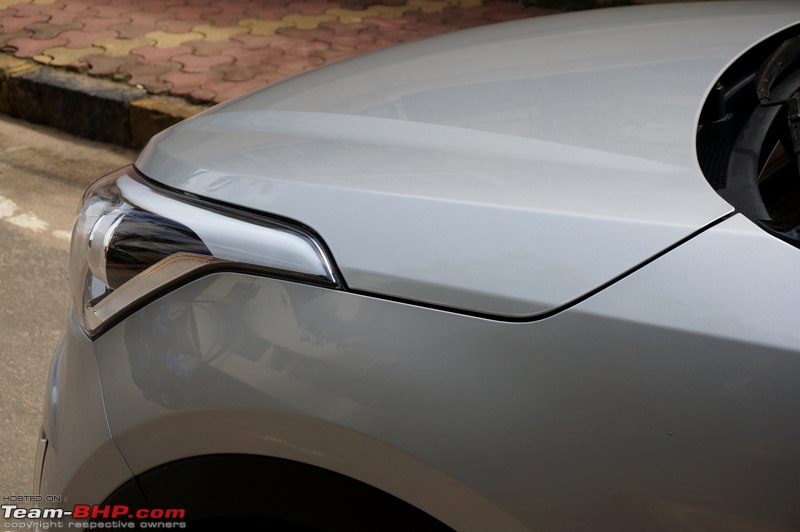 Windshield washers hidden under the bonnet (unlike the Duster & EcoSport). Effective spray too:  The A-Pillars are stylishly clad in shiny black, while the B-Pillars & entire window frame area get matt black treatment:  Wing mirrors with integrated turn signals. In the much cheaper i20, they auto-fold in & out as you lock & unlock the car. Creta? Nope. So many missing features & functions in this 'premium' SUV!   Chrome door handles with a 'request sensor' on the driver's side only. 6 lakh rupee Grand i10 gets them on both doors. An endless blunder of features allocation, seriously!  Wheel arches filled up by the 17” rims wearing 215/60 tyres. Janta will like the diamond cut design, although they're not to my taste (look too flowery in the way that the spokes come out). The tyres are adequately sized for the weight and power on tap. Lesser variants make do with 16” wheels running on 205/65 rubber. The 215s of the SX(O) offer a better stance than the lower variant's 205s:  A closer look at the body cladding that runs across the Creta:  Many new cars have started using flaps ahead of the front tyres (for aerodynamics). The Creta has them for the rear wheels too:  Form over function - rear window line results in loss of glass area. Window size limited by the roofline tapering down and the waistline tapering up. Compare that to the enormous glass area of the XUV500!  You’ve got to give it to Hyundai’s attention to detail. The fit & finish of even an odd item like this triangular plastic body filler (right behind the rear quarter glass) is perfect:  Unlike the Chinese ix25's flush fitting roof rails (image link), the Creta gets raised roof rails:  Ribbed roof for structural rigidity, in addition to the 5 crossbeams underneath: 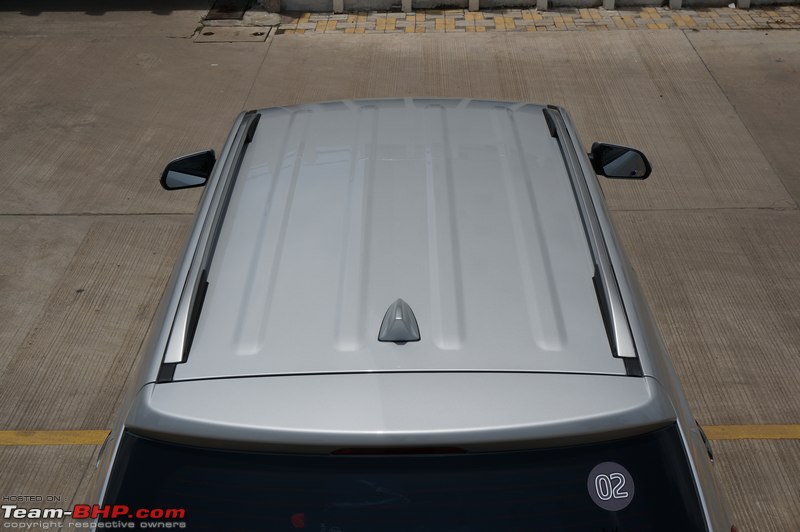 BMW-esque sharkfin antenna sits at the end of the roof. It works for both, radio and GPS signals:  Just like the headlamps, the tail-lamps also bulge out of the body line:  The tail-lamp cluster is a fully functional unit (including the section that's on the tail-gate):  The well-integrated rear spoiler: 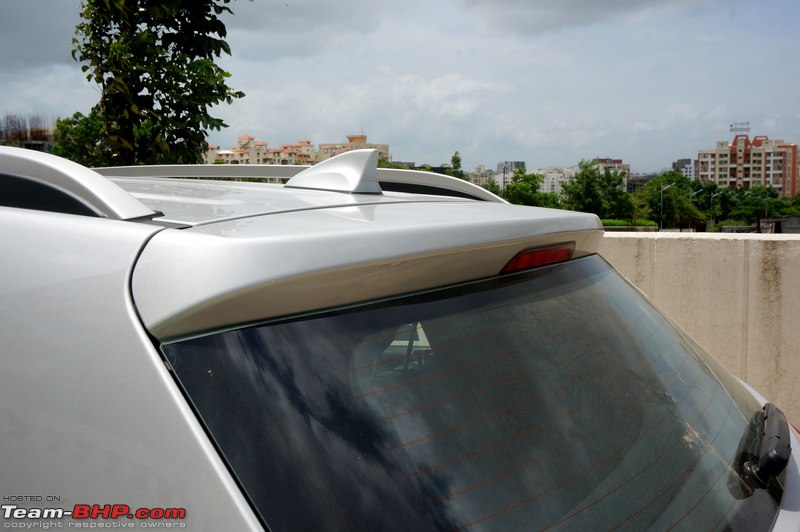 Rear washer jet is camouflaged in red...nearly invisible:  Ugly chrome garnish is so tasteless! You can get away with it on lighter shades like silver or white, but it looks awful on darker colours (e.g. black). Body-colouring this strip will be a popular mod with those who like things subtle:  Reversing camera neatly tucked under the chrome strip:  Rear bumper gets faux skid plates as well. 4 rear parking sensors, two of which are nicely placed in the black cut-out section:  Ultra-high tensile steel body structure with protection in all directions from 'ring-shaped frames'. In addition to the ribbed roof, there are 5 cross members that provide additional reinforcement and protection:  The position of the 6 airbags. Only on the top variant though:  While the Creta is smart & clean, the Terrano & Duster are more butch & muscular:  Just look at how beefed up the Terrano's wheel arches are! Observe their different positioning of the rear quarter glasses:  Rear comparison: 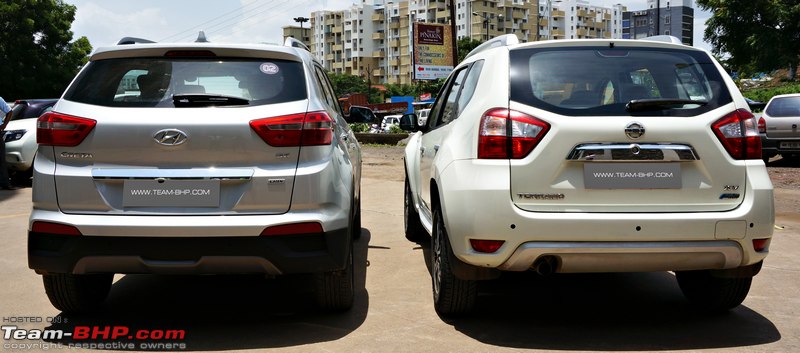 EcoSport is young & funky, but the Creta's mature styling has broader appeal:  From the side, the EcoSport screams 'sub-4 meter benefits'!  What a difference the tail-mounted spare makes:  The Creta's presence is no match for traditional ladder-on-frame SUVs. A Safari owner will still look down on the Creta in traffic. If you want maximum real estate for your money, hop into a Tata or Mahindra showroom instead:  Last edited by Aditya : 30th August 2015 at 09:05. |
| |  (72)
Thanks (72)
Thanks
 |
| The following 72 BHPians Thank moralfibre for this useful post: | Aditya, aeroamit, AkMar, amit_purohit20, ampere, anilntny, AutoIndian, BoneCollector, countdredd, crackparag, CrAzY dRiVeR, Cruiser_D, dkaile, ecosport rules, Ferruccio, ganeshb, Geo_Ipe, gpa, GTO, guptashish, hybridpetrol, iliketurtles, InControl, IronH4WK, Jaggu, jeetaman, joy_swift, lloydofcochin, mayank0782, mh09ad5578, MindOnWheels, mrbaddy, naveen.raju, noopster, pbishayee, peterjim13, phynix123, psurelia, rav11stars, RavenAvi, rednikhil, RoadSurfer, rockporiom, rohansachar, RSR, S2!!!, samabhi, scopriobharath, SDP, sdp1975, Sheel, sidhu_hs, Simhi, SnS_12, sourabhzen, super.cars, swiftnfurious, tanwaramit, Technocrat, Thar4x4, The Rationalist, theexperthand, theredliner, turbospooler, Turbo_asd, Tushar, vb-saan, vibbs, VijayAnand1, Vitalstatistiks, Whichcarnow, yosbert |
| | #3 |
| Team-BHP Support  Join Date: Dec 2004 Location: MH-12
Posts: 8,443
Thanked: 13,956 Times
| re: Review: Hyundai Creta (1st-gen) 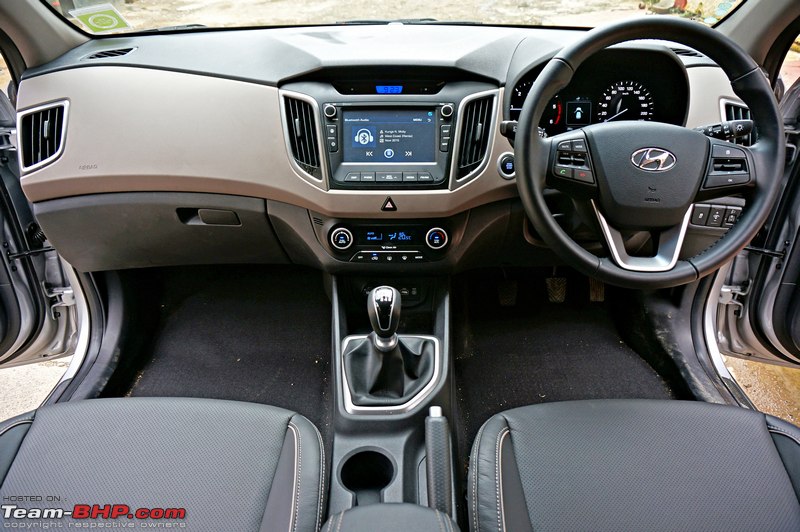 With pure keyless entry, as long as the smartkey is in your pocket, simply walk up to the Creta and press the request sensor (on the door handle) to lock & unlock. The system gives you a single, mild beep when you lock the SUV and two beeps when you unlock. The locking system is smartly designed = if the key is inside the car, you won't be able to lock it even by mistake. Additionally, if any of the doors are open and you press the request sensor, it'll just give you a long warning beep and refuse to lock the car. On the move, try to pull on the door unlock knob (inside) and it'll immediately force its way back to the lock position. In fact, while it's doing that, you can see all of the door locks engage, as if the car is centrally locking itself again. It'll attempt to do this thrice, after which the system gives up. The Creta is positioned just like other monocoque SUVs (read = not too high) and you 'sit down' on the seats. The extended running board / side cladding adds a couple of extra inches to the distance between the seat and the roadside. Not much of an issue while getting in, but you do need to stretch your feet out far to exit the SUV. On the inside, you are greeted by an all-black facia, sandwiching a dark beige section running across the breadth of the uncluttered dashboard. Thankfully, manufacturers have come to realise that black interiors can look appealing and are easier to maintain than the typical sea of beige. On the flipside, the black interiors definitely make the cabin feel less roomy than it actually is. We're not sure how black will work with the masses as a large majority still prefer beige interiors. The upper half of the cabin (roof and A-B-C pillars) is finished in a dark beige / light brown shade. This is a welcome contrast. The large glass area brings in a lot of light and adds to the airy feel. Cabin quality is more or less like the Elite i20. Despite the lack of soft touch plastics or premium grade materials, overall quality feels good. Just like the outside, fit & finish are impeccable on the inside. All panels are well screwed together. The top variant gets some 'feel good' leatherette on the seats, driver armrest, door inserts, gear lever and steering (steering seems to get real leather). Even smaller stuff like the cover on the 12V power socket is constructed such that you just know it's going to last the car's lifetime. A lot of parts have been lifted from the Hyundai common parts bin, not a bad thing as Hyundai is the segment leader in terms of quality. The front door's grab handle is big, meaty & very 'SUV style'. The doorpads are perhaps the only place where you'll see some low rent material. What also feels cheap here are the non-illuminated passenger window buttons (only the driver's window button is illuminated). Must add, because the 7-9 lakh Elite i20 uses materials of a similar grade, customers would naturally expect more in a higher-priced vehicle. Those who buy the 16 -17 lakh SX(O) will be satisfied, but won't have anything to write home about. Don't get me wrong, there's nothing wrong with the Creta's quality. It's just that there is no 'wow' factor like there was in the i20 (keeping the hatchback's pricing in mind). In a car costing twice as much, we'd want some of that Elantra soft-touch magic. Further, the lower variants feel like they're two notches down, due to the missing leather. Even the smallest bits like the gearknob and armrest lose the leather treatment. Cabin space at the front is satisfactory. The width ensures that two heavy occupants won’t rub their elbows against each other. Move the seat back for a 6 footer and there’s still some room for passengers on the back seat. In terms of headroom, there’s more than enough of it for the tallest of drivers. The front seats are well bolstered with adequate under-thigh and lateral support for small to medium weight occupants. If you are on the heftier side, the seats (especially the bolstering) will feel a little too snug. The seat covers provided are made of art leather, but still have a nice feel. The contrast white stitching stands out and is done up tastefully. The stitching pattern is carried over to the doorpads as well as the armrest. The seat's center area gets smart looking perforated leather. The compound is on the firmer side and feels just right (front is noticeably firmer than the rear). A major downside though is the poor lower back support. Those with a weak back will find it to be woefully inadequate. Trust me, this car needs adjustable lumbar support. The seat height adjuster with its 20 step range helps in getting the right driving position. You could crank it up to either get a tall SUV'ish driving position or place it low to a C-segment sedan style level (not too low though). GTO is 5'10" and he can still see the bonnet from the front seat. Some folk like that. As if to complement the height adjustment, the fore & aft travel range is ample. The driver's armrest is functional, but doesn’t get any adjustments. Predictably, it'll suit the driving position of some drivers only (not all). The leather-clad gear lever is small in size (unlike the usually tall SUV units). It's just what you would see in a premium hatchback or sedan. The non-leather gearknob of lesser variants feels el cheapo though. The driver footwell is well-spaced, and the perfectly positioned dead pedal is big enough to comfortably support larger shoe sizes. Ergonomically, there’s no oddly placed button or control - a notable advantage as the Duster's ergonomics are messed up. Spend some time in the cabin and you’ll be right at home. It's very user-friendly. The leather wrapped steering wheel with thumb contours is great to hold. Although the size is adequate, some might feel that it's too small for an SUV. You'll like the big steering mounted buttons...they're easy to operate. Shockingly, while the 1/2 price Elite i20 gets steering reach adjustment, the Creta doesn't! What were Hyundai's product planners thinking? In a car of this price, telescopic adjustment is mandatory! To its credit though, the steering is positioned correctly; only the shortest & tallest of drivers will miss the reach adjustment. Also, the tilt adjustment has a healthy range. The Audi-esque instrument cluster scores on readability with sufficiently sized fonts. The cluster remains illuminated during the day as well. Its brightness level can be adjusted from level 1 to 20, as per your preference. The digital temperature & fuel gauges are displayed below the revv-counter & speedometer (respectively) on the top variant. Lesser variants have them on the MID. You can pull up a digital speedometer on the MID if you so wish. Classy touch: the cluster's illumination fades in & out when you start / stop the car. The SX(O) gets a functional MID offering a host of settings which you can browse through using the steering's RHS buttons. These settings are covered in detail via pictures below. Lower variants don't get any of these settings; they only have one fixed MID screen. Hyundai’s refusal to provide fuel-efficiency data and the handy distance-to-empty counter is disappointing. We simply can't understand Hyundai's stubbornness here! The SUV'ish stance helps in getting a clear view of the road ahead. Despite being quite thick, the A-pillars don't obstruct the driver's view like they do in say, the Swift & Civic. Try reversing though and the thick D-pillars will hamper visibility to a great extent. It's easy to miss a person or large object due to the blind spot they create. The small rear windscreen only adds to rear visibility woes. Those who buy the higher variant will thank the parking sensors and reversing camera, but owners of lesser variants will surely miss them. Interestingly, the reversing camera display is on the touchscreen while the parking sensor display is on the MID. The rear view mirror is par for the course, and the ORVMs are wide enough (always a good thing in India). The ICE touchscreen eliminates clutter and stands out in the cabin. This 7” screen is placed prominently and plays a big part in enhancing interior look & feel. The HU takes AUX, USB and Bluetooth audio inputs. Keeping up with the times, a CD player has been skipped (who uses CDs today anyway?). It also doubles up as a navigation screen, with maps provided by MapMyIndia. A pair of co-axials at the rear and mids & tweeters at the front make up the sound stage. Set up the equalizer properly and you'll find the audio quality to be satisfactory. No need to upgrade the hardware. Even at full volume, there was no crackling or distortion from the speakers. That said, those who prefer ultra-loud music levels will feel that the system volume doesn't go high enough at its fullest setting. A pleasant surprise: The response from the touchscreen is prompt, and the logically placed buttons (on the display) make it a breeze to use. There’s no lag or any of the buggy nature we found in early versions of the Mobilio & Ciaz touchscreens. Hyundai got this one right. For those that are hooked on to A2DP for music & calling, pairing your Bluetooth smartphone is a breeze. The battery status and signal strength show up on the HU once your phone is successfully paired. You can play videos via USB as well. However, keeping safety in mind, video playback is only possible when the vehicle is stationary. It's not all smooth sailing though. In some driving positions, there is a considerable amount of glare on the screen that makes a large section of it unreadable. Also, even at full brightness, the display suffers from poor readability under bright sunlight. This feature is cool or annoying, depending on your perspective. Even though we didn’t switch the navigation on after starting the car, whenever there was a steep curve ahead, we would get a warning - a female voice would tell us ''curve ahead''. The warning comes up when you have the music playing too. I had my phone connected and the warning interrupted the song, told me there was a curve ahead and then resumed the music. This prompt comes up for long & sharp curves, based on what we've seen. Not sure if there's a setting to disable it. The climate control is easy to operate with properly sized knobs & buttons. The vertically placed air-con vents distribute a fair amount of air throughout the cabin. We tested the Creta's air-con on a hot day in Mumbai and it was capable of keeping the cabin comfortable (as most Hyundai air-cons are). The blower offers 8 levels of adjustment to suit your needs. However, there is quite a mismatch in the air volume that is let out from the front vents versus the rear. For example, set the blower speed to level 3 and things are ideal for front passengers, but those on the rear seat will get only a small amount of airflow. At level 4 & up, things get better for rear passengers, but front occupants will feel it's too much! The rear air-con should have been better synced with the front. The Creta offers practical in-cabin storage solutions. All door pockets can hold 1L bottles. Besides the bottles, the pockets have space left over for knick knacks too. Right ahead of the gear lever, you get room for a pair of big smartphones (for you and the front passenger). This area has a rubbery base and is very accommodating, with tall edges on the side. There are two differently sized cup-holders to the left of the handbrake, of which the bigger one can hold a 1L bottle. Right under the driver's armrest, you'll find a deep storage cubicle. Open the glovebox and it just drops open, with none of that damped effect that you'd expect after spending 15 big ones. The glovebox is medium-sized, but it's all hard plastic on the inside. There's no felt-lining, illumination or cooling vent here (all you get is a ticket / card holder). At the roof level, Hyundai has provided a felt-lined sunglass holder. The Creta wears a tasteful combination of black & dark beige on the dashboard. A refreshing change from the usual beige or grey. Notice how the dark beige section extends out to the doorpads. The smart looking fascia has minimal clutter and is very functional. There is no 'wow' factor though. Quality is similar to the Elite i20. Good, but we expect more from Hyundai when paying a higher price:  Leather-wrapped steering wheel feels nice to hold, especially with the thumb contours that provide the necessary grip. Some might feel that it's a size too small in an SUV. All the steering mounted controls are intuitive to use and sport large buttons for easy operation. The horn pad is convenient to access:  Shockingly, no reach adjustment here (only tilt):  LHS buttons are dedicated to the ICE and Bluetooth telephony. Mute button can be super useful. Toggle switches for volume and track seek are fab! RHS controls serve the MID & settings within. Only the top-end SX(O) variant gets a host of functions that can be customised from the MID: 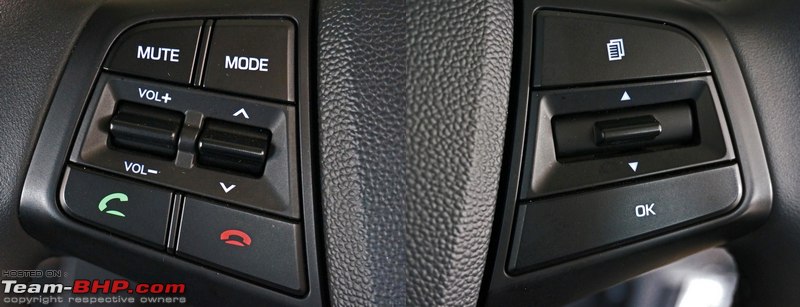 Instrument cluster stays illuminated even during the day. A large font size makes the dials easy to read. That 4,750 rpm redline tells you this is the diesel. Digital fuel and temperature gauges at the bottom:  The MID's homescreen has three display options i.e. trip A, trip B and a digital speedometer. Both trip meters show the distance travelled, average speed and time taken (specific to that trip meter). We think it's unnecessary to permanently show the 'hold ok to reset' text below. Turn the engine off and the MID immediately pulls up a drive summary (distance, speed, time). Second screen on the MID tells you when the service is due, in terms of kilometers as well as number of days left (you can set these values yourself):  1. Traction control can be disabled via a button placed to the driver's right (useful when starting off on a slippery surface). 2. A long press of the same button will disable the ESP (don't ever do this). 3. If the key is moved outside the vehicle, the MID pops a warning for the same. 4. There’s a layman feature that prompts you to straighten the steering wheel before you start driving; it even tells you the direction you need to turn in. 5. While the reversing camera display is on the ICE touchscreen, the parking sensor display comes up on the MID as soon as reverse gear is engaged. 6. You can set the cluster's illumination between levels 0 - 20!  Many settings within the MID. Among other things, you can set up the auto door locking (when you drive away) & unlocking (when you switch the engine off), follow-me-home lights, number of flashes for the 'lane change indicator', service intervals and more: 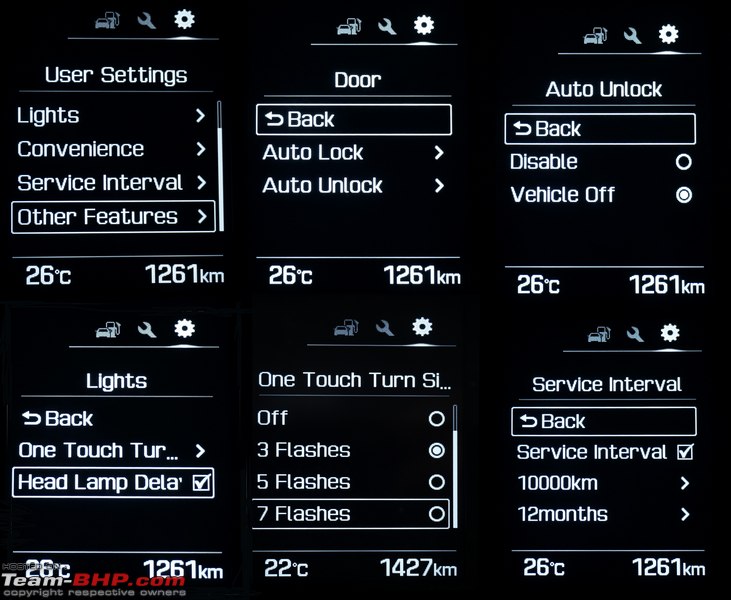 Control stalks feel durable. Interestingly, the foglamps can be turned on or off via a toggle switch on the RHS stalk. You can operate this toggle switch from the front or back of the stalk. The LHS stalk is dedicated to wiper functions. Using the toggle switch, you can set the intermittent wiper's delay. The wipers have a big sweep and the passenger side blade clears a good part of the glass area in front of the driver too. It's like a double sweep in that area. At this price, we would have expected 'auto wipers' as standard:  The gearshift suggestion tool on the MID prompts you to upshift / downshift as required. In this image, it's asking the driver to upshift to 3rd. The system is tuned for efficiency and makes its suggestions accordingly. Drive hard and you'll see it telling you to move two gears up (i.e. 3rd to 5th):  The engine start / stop button. A tap on the button without the clutch pedal pressed will activate the 'audio on' (yellow light) and 'ignition on' (blue light) modes:  On the RHS panel are three buttons - traction control off, dash illumination adjustment and headlamp leveller:  Doorpad with a big SUV style grab handle. Armrest is useable and has leatherette inserts around. Notice how the speaker placement makes way for more space in the doorpad. Pockets can hold bottles as well as the knick knacks:  Even the door handles are built of quality material. Try to unlock on the move and the system will put up a resistance:  Nice placement for the ORVM controls. While they are electrically adjustable & foldable, you don't get the auto fold / unfold feature of the i20: 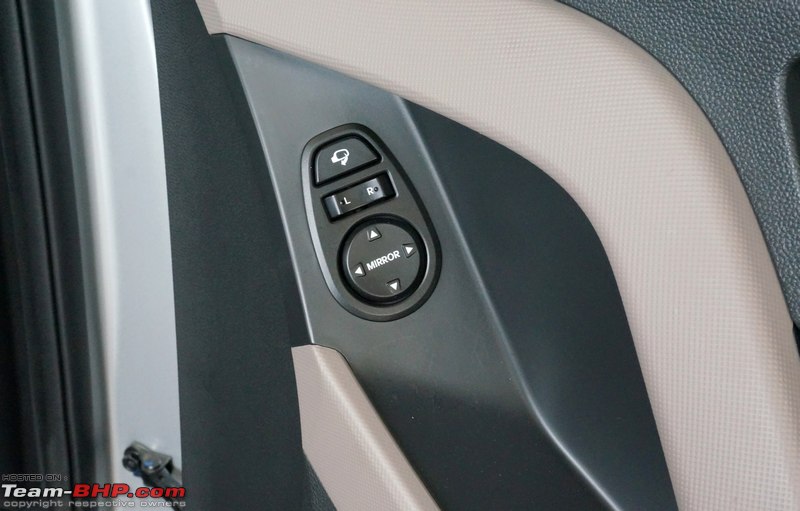 Standard switchgear on the driver's side. Driver's window has one-touch up & down functionality. You don’t get backlit buttons! When was the last time we complained about the lack of features in a Hyundai?!  A closer look at the door pocket. Even with a 1L bottle in place, there’s enough space left over for odd items:  Scuff plates on all 4 doors. Nope, they aren't badged or illuminated:  Well-bolstered leatherette (read: not real leather) seats provide good support for small to average sized occupants. Those who are overweight might find them to be too snug. Lower back support is severely lacking though. If you have a weak back, this isn't the seat for you. The upholstery is tasteful and the stitch quality really nice. Driving position reminds us a lot of the previous-gen Honda CR-V: 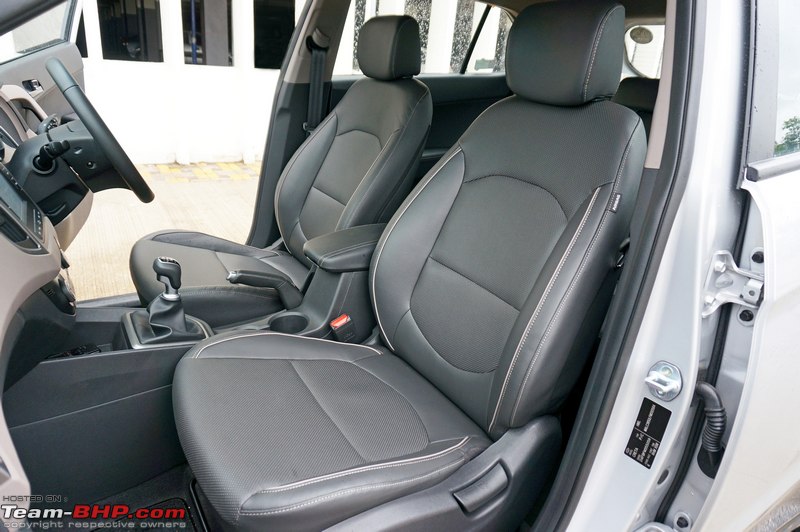 Driver armrest gets leather, but no adjustments. Its fixed position will suit some drivers (not all):  Healthy range of adjustment for the seat height: 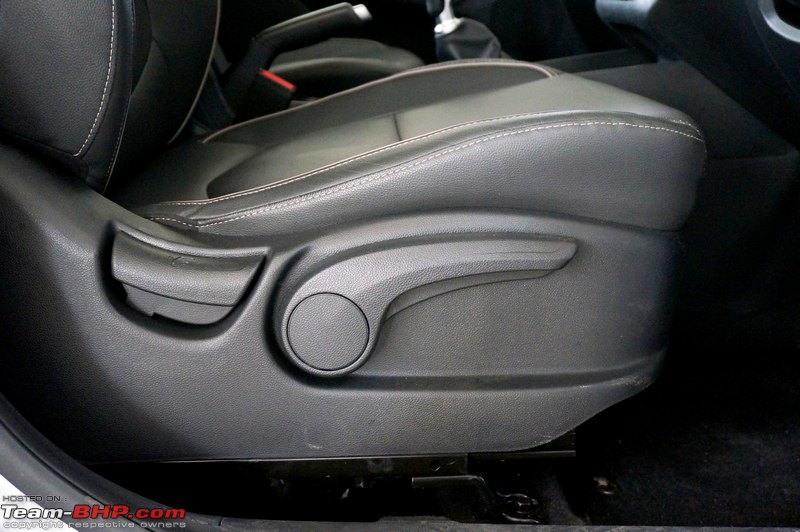 Adequate space in the footwell. Dead pedal is perfectly positioned:  Keyfob gets the chrome treatment. Chocolate brown colour - seriously? Choco-brown isn't used anywhere else on the Creta. In this image, the perforated (middle) area of the seats is visible: 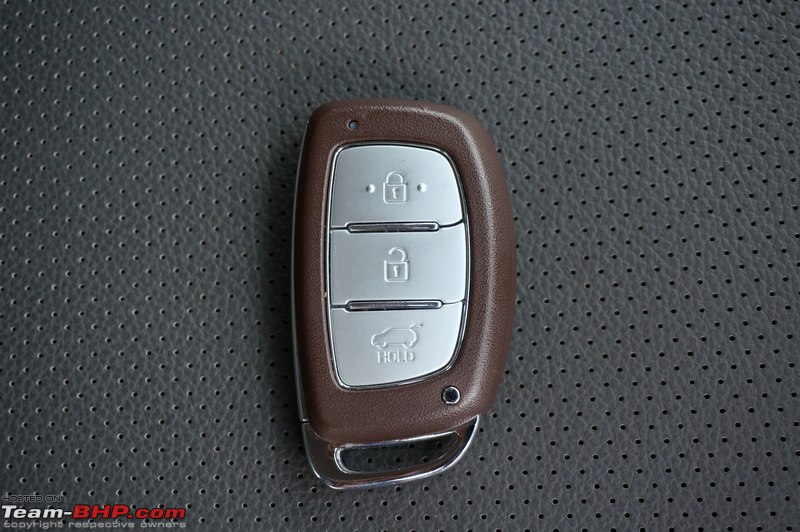 ORVMs offer a good view of the action behind:  IRVM is alright, but the small rear windscreen restricts visibility. This isn't an electrochromatic unit; you have to manually switch between day / night mode!!  Along with the small windscreen, the thick D-Pillars hamper rearward visibility. Wiper unit too takes up some of the view. You will need that reversing camera: 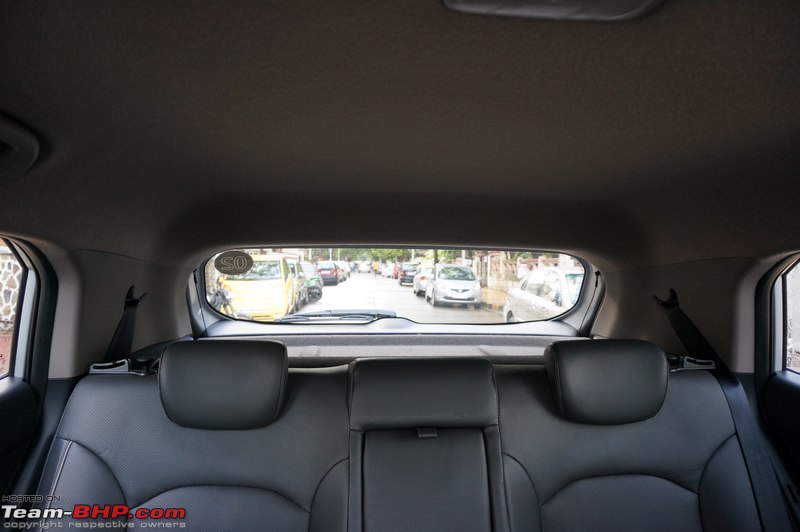 Center console is well laid out with minimal clutter. Touchscreen is a highlight (covered in the next post):  All air-con vents are vertically placed. While each one can be shut individually, they still let out a small volume of air anyway:  Climate control is powerful and the large buttons make it easy to operate. Rotary knobs for temperature & airflow are well-built: 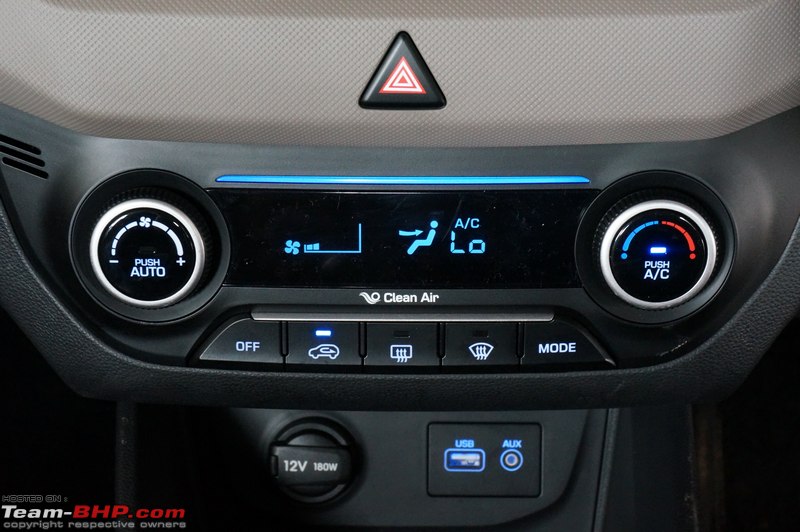 See that light strip placed above the climate control display? It glows blue if the temperature is set low. As you increase the temperature, the strip turns white, eventually going amber in the higher temperature range. The marketing team calls this a “mood bar”:  Accommodating storage area - with a rubber base - ahead of the gear lever:  12V charging socket with illuminated USB & AUX inputs:  Two differently-sized cupholders to the left of the handbrake:  Under the driver's armrest is the perfect place to park your keys, wallet etc. Carpeted base here:  Medium size glovebox. No cooling vent provided:  Small cut-out with a clip inside the glovebox. For parking slips or your business card:  The cabin light console. Bluetooth microphone placed here:  Felt-lined sunglass holder: 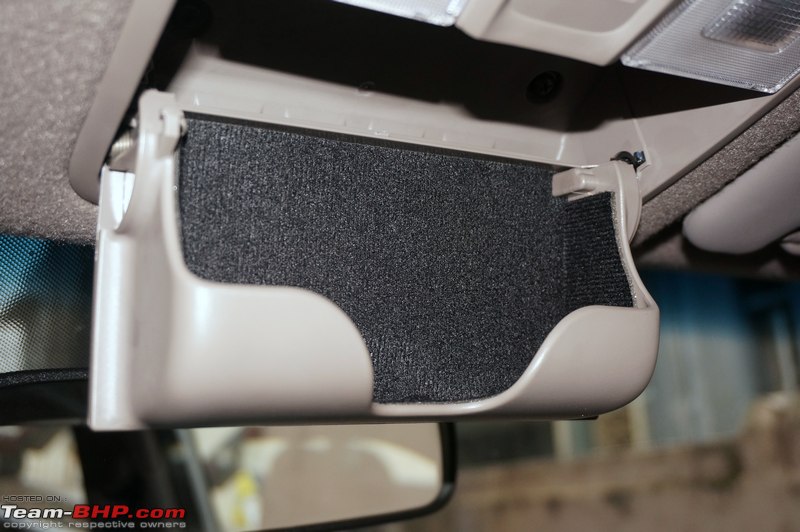 Cheap sunvisors aren't expected in a Rs. 16 lakh Hyundai and we hope that the Creta isn't a sign of things to come from the Korean giant. Passenger's sunvisor has a big vanity mirror, but no light:  Height-adjustable front seatbelts:  Airbag here means no after-market seat covers please!  SX(O) gets 6 airbags in total! 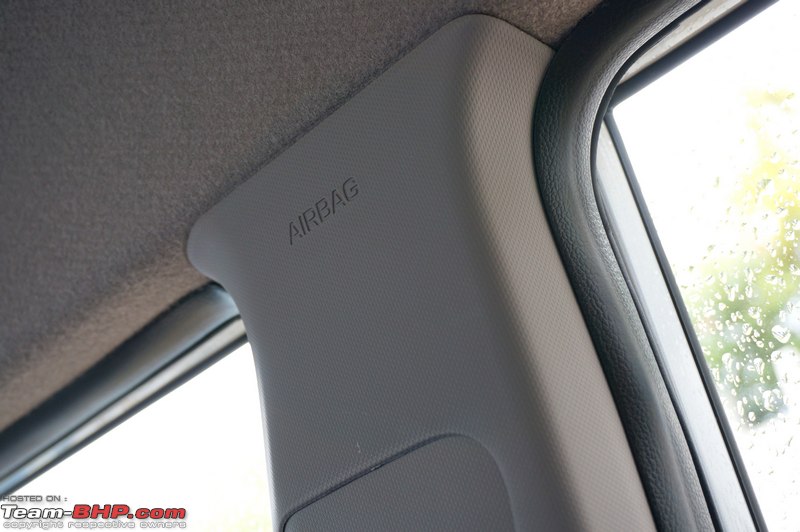 Last edited by Aditya : 30th August 2015 at 16:52. |
| |  (38)
Thanks (38)
Thanks
 |
| The following 38 BHPians Thank moralfibre for this useful post: | Aditya, aeroamit, AkMar, AutoIndian, CrAzY dRiVeR, dkaile, ecosport rules, fusionbang, GTO, guptashish, iliketurtles, Jaggu, mh09ad5578, mi2n, MindOnWheels, mrbaddy, naveen.raju, rav11stars, RavenAvi, razor4077, S2!!!, samabhi, scopriobharath, SDP, Sheel, sidhu_hs, Simhi, SnS_12, swiftnfurious, Technocrat, theexperthand, theredliner, Turbo_asd, Tushar, vb-saan, vibbs, vikred, yosbert |
| | #4 |
| Team-BHP Support  Join Date: Dec 2004 Location: MH-12
Posts: 8,443
Thanked: 13,956 Times
| re: Review: Hyundai Creta (1st-gen) The In-Car Entertainment System 7" touchscreen ICE is bug-free (unlike the early HUs of the Mobilio & Ciaz). Hyundai got it right. The touchscreen is quite responsive. Buttons are big enough:  How terribly annoying! Every time you start the car, you have to 'agree' before using the ICE:  The head-unit accepts the usual inputs, but doesn't have an SD card slot. Lower variants without navigation get 1 GB of internal memory for MP3s:  Sound quality is satisfactory. No distortion either. However, the volume doesn't go as high up as some of you might like:  The system offers four preset equalizers to choose from:  You can set the bass, mids & treble yourself too. The fader adjuster is superb! Move the fader with your finger on the touchscreen:  You can set the volume that the system starts at: 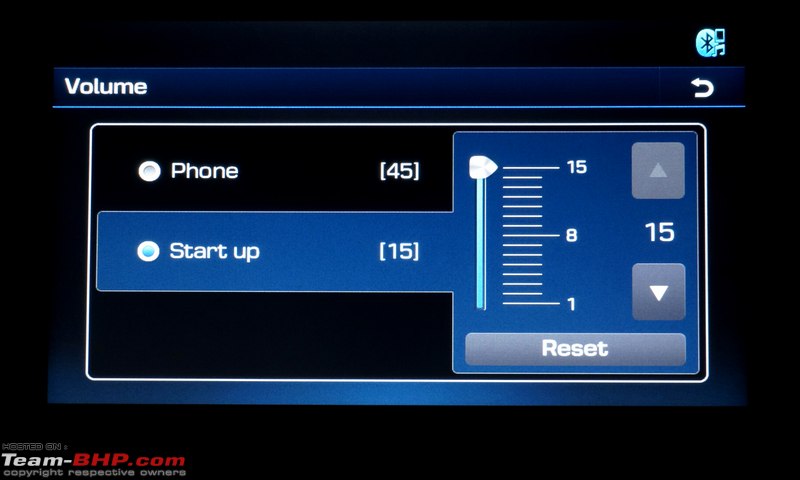 Wife making you wait? Watch some F1 videos off a USB stick, but only when the car is stationary:  Use the ICE without the engine running and a 'battery discharge warning' will be displayed:  The touchscreen doubles up as a reversing camera display. Yep, it has colour-coded adaptive parking guidelines (that move with steering input):  The display’s brightness levels can be set to 'auto' (dims whenever you start the headlights), or by choosing day / night mode: 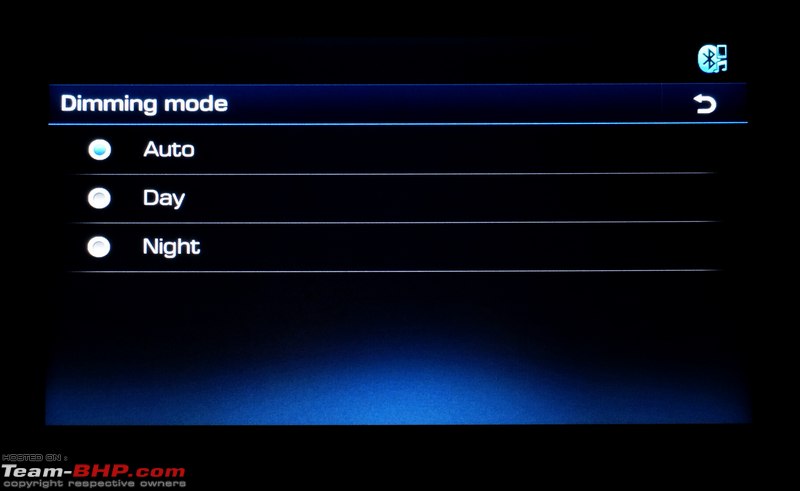 Alternatively, the brightness can be setup manually:  Unfortunately, for all the brightness settings, the screen suffers from poor visibility under bright sunlight. It's worse than what's seen in this close-up camera image: 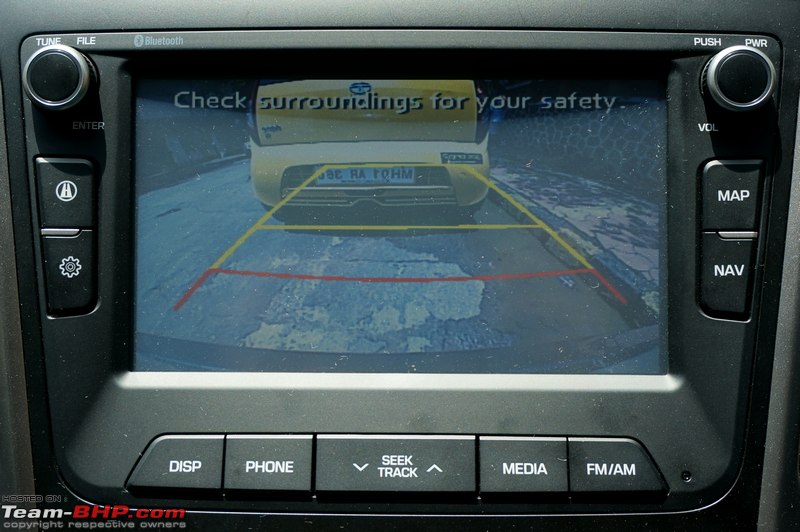 If the screen distracts you at night, press the 'DISP' button to turn it off. Press the touchscreen anywhere to bring it back on: 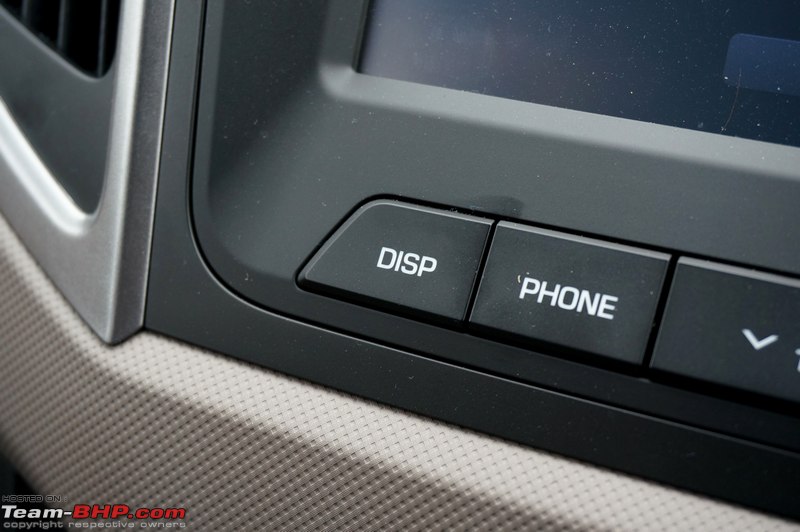 Start the navigation and you’ll see the current street name, distance to continue on the path and the drive time till the next action. You can mute / unmute the spoken instructions by tapping the speaker icon:  The map's viewing scale can be customised - you can take a wider or narrower view - down to as low as 25 m:  Switch on the headlamps and the map will automatically move to night mode. Nice touch:  Each mode has two colour options. The colour of the route indicator line can also be chosen from four available options:  Wondering who the provider is? MapMyIndia. You get three free map updates through the warranty period (1 every year):  Everyone offers POIs...  ...what's cool is the automotive category. Hyundai service stations & dealerships at the top! Got to appreciate the attention to detail:  Other brand workshops included too:  Select “near current point” and the closest service centers appear on the list:  The recreation category for some weekend fun:  It will always suggest the best route. Seen here are two options, of which one is relatively shorter in terms of distance, but will actually end up taking more time:  Set up 5 favourites to quickly pick up the destination address:  This can be very useful when commuting in unfamiliar cities. Enable the recent destinations list to quickly pick a location on the maps:  Among other viewing options, you can choose the map's orientation. Activating 'scale auto change' will zoom the map to the lowest view (25 m) as you approach your destination:  Hindi navigation for the masses:  Last edited by Aditya : 30th August 2015 at 14:24. |
| |  (51)
Thanks (51)
Thanks
 |
| The following 51 BHPians Thank moralfibre for this useful post: | Aditya, aeroamit, AkMar, anilntny, Aragorn, AutoIndian, blahman, BNM, CrAzY dRiVeR, dkaile, DrANTO, ecosport rules, GTO, guptashish, iliketurtles, InControl, Jaggu, kingofkings, lloydofcochin, mh09ad5578, MindOnWheels, mrbaddy, naveen.raju, noopster, pbishayee, rakesh_r, RavenAvi, rednikhil, RSR, S2!!!, samabhi, scopriobharath, SDP, Sheel, sidhu_hs, SmartCat, SnS_12, swiftnfurious, Technocrat, theexperthand, theredliner, timuseravan, turbospooler, Turbo_asd, Tushar, vb-saan, VijayAnand1, vikred, vredesbyrd, yajaman99, yosbert |
| | #5 |
| Team-BHP Support  Join Date: Dec 2004 Location: MH-12
Posts: 8,443
Thanked: 13,956 Times
| re: Review: Hyundai Creta (1st-gen) Just like it was at the front, there is quite a difference between the seat & the ground, thanks to the extended body cladding. You have to lift your feet over that wide area to get in. Normally, the second row of seats is placed higher than the first row in SUVs, but that's not the case with the Creta. You sit down & low, and will find this seating position to be more like a regular C-segment sedan. Fellow Moderator Anshuman who had a chance to sit in the Chinese version commented that the Indian Creta appears to have its seat placed lower. Without doubt, the rear seat should have been designed a little higher. The Creta has a healthy amount of legroom at the back. Owners will have no complaints in this area. Two 6 footers can easily accommodate themselves one behind the other. Even with the front seat pushed all the way behind, a tall occupant can fit in. If you're sitting behind a normal 5'10" or shorter driver, you'll have ample legroom. Not only that, there is lots of foot room available below the front seats to slide your shoes in. In terms of width, the rear seat can accommodate two healthy adults, not three. Three would be a squeeze. In our opinion, the Creta is suitable for 4 adults & a kid onboard. Yes, the floor is flat and the rear air-con doesn't intrude into legroom much, but the seat isn't as wide as the Duster's. The 5th seat occupant would anyway feel unwelcome due to the raised center section of the seat and the poking armrest (in his back). 4 big adults onboard is ideal; all can travel very comfortably over long distances. The seat compound, especially on the base of the rear bench, is on the softer side (as compared to the front). The rear seat itself is very supportive. Back support is satisfactory, and the seatback runs high enough to accommodate taller occupants. No issues with under-thigh support either. The seatback is at the perfect angle, although there's no recline adjustment like in the EcoSport. All 3 occupants get an individual headrest / neck restraint. These are small in size, yet have a good adjustment range. Importantly, the armrest is positioned such that it's very usable (unlike the S-Cross which we recently tested). The door armrests run along the entire length of the doorpad, and are a comfortable place to rest your arm on the move. Rear passengers will find the tall window sill to be a major turnoff! The view outside is greatly restricted - more so for short passengers - and it blocks the light coming in too. The glass area has decent length and you won't feel claustrophobic, albeit it's not super bright or airy at the rear. Just like the front door pockets, the rear ones can hold a 1L bottle each. Even with a bottle in place, the wide pockets have enough space left over for odd items. The foldable center armrest houses two cup-holders, and the two seatback pockets have good depth. Funnily enough, the top SX(O) variant doesn't get bag hooks on its folding grab handles, although the lower variants do (on their fixed grab handles). Yet another variant mismatch = the top-end variant has a single piece bench seat, whereas the AT variant, which sits a notch lower on equipment, gets a 60:40 splitting seat. To add to that, the 60:40 splitting seats have two ISOFIX mounts for anchoring a child seat. The top-end SX(O) has no such arrangement. Why this kolaveri, Hyundai? The 402 liter boot is practical and the squarish layout means that it can hold more luggage than sedans with a similar boot capacity. Still, the norm in this price range is ~500 liters of capacity (the Duster has a larger 475 liter boot). You can fold the rear seat down to help a friend who's moving home. Boot intrusions are at the bare minimum (mainly on the left due to the fuel filler) and Hyundai provides a luggage net too. You'll find two storage cubicles on either side of the boot to dump stuff like a first aid kit etc. On the flip side, the loading lip is high and you'll have to lift heavy bags up to bring them in. You'll also find that the boot floor sits at nearly the same level as the opening. The Creta is a rare SUV to have its full-sized spare wheel located in the boot itself. Accessing the spare is far easier than in the Duster which has it fixed under the body. What's more, the spare wheel cover locks in 'open position', leaving both your hands free for accessing the wheel & tools  . .The doors open wide enough...  ...but egress (especially) & ingress aren't effortless. See how much width the side body cladding adds here. You have to lift your feet over this entire area when getting in & out. Also visible in this image is the rear door sill:  The rear doorpad. Armrest runs the entire length! 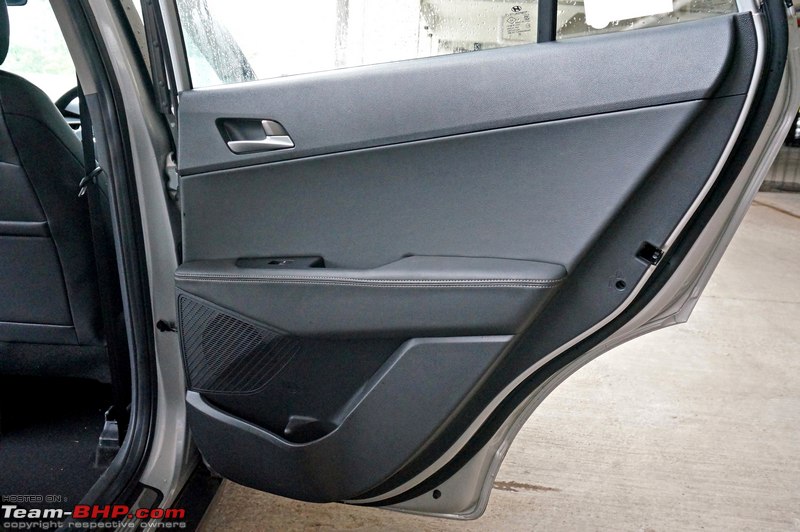 Soft inserts where you rest your arm:  A 1L bottle holder and a little storage space on the doorpad:  Sufficient legroom at the back. The seat is supportive, even if it is positioned on the lower side. Backrest has a nice recline angle:  Even behind an extremely tall driver, there is some legroom available:  What an awkwardly shaped rear window - notice how the window sill rises up! Shorter passengers will hate it. This greatly reduces their view outside, and also blocks light from coming in. Not a bright & airy rear bench, as you can see: 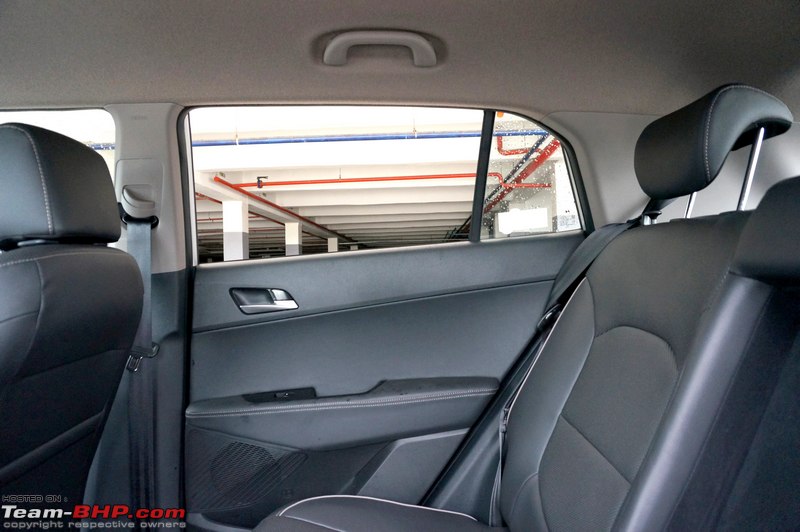 Comfortable center armrest with two cupholders. Placed at just the right height:  Even the area behind it is soft (some cars have rock hard plastic here):  Two adjustable headrests. They are wide enough:  Ample room to slide your feet in, even if you wear large shoes:  Floor hump is marginal. Still, the backseat is best for 2 adults & a kid. 3 healthy adults here will be too tight:  The rear air-con with two adjustable vents & a common air volume setting:  12V power socket below for smartphones at the back: 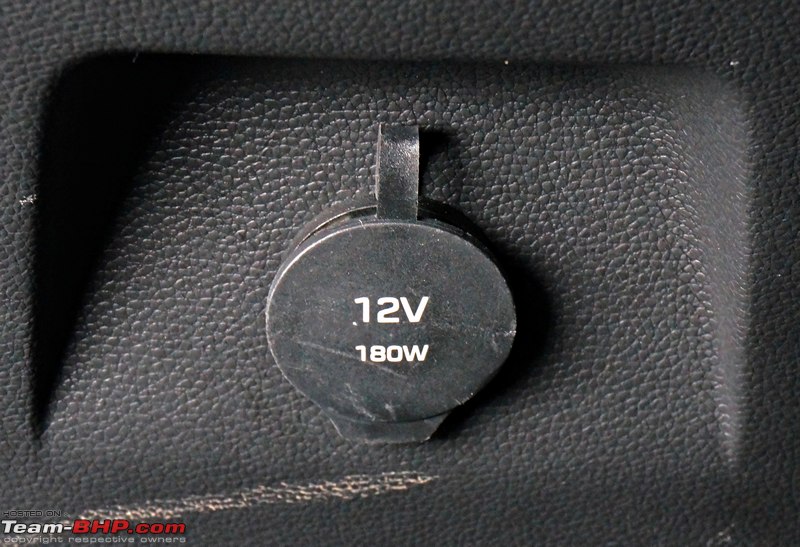 Two nifty seatback pockets:  Rear seatbelts are nicely mounted on the C-Pillar. Middle passenger only gets a lap belt:  Check out how the seatbelt is channelled (at the top). On the side is a slot to park the buckle when not in use:  Rear cabin lamp is placed right above where the rear seat begins:  Spring-loaded grab handles. Strangely, the SX(O) misses out on those useful hooks (lower variant's fixed grab handles have them):  Rear window rolls all the way down:  The tail-gate opened up:  You will have to lift your bags 'up':  Big parcel tray covering the boot:  402 liter boot has a practical layout and is fairly accommodating. That said, the norm at this price point is 500 liters (Duster has a larger 475 liter boot). LHS intrusion is bigger as that's where the fuel filler is:  Fold the seat down when you want to move home. Only the Creta Automatic gets a splitting rear seat:  Yes, the boot area is illuminated:  Storage cubicles on either side of the boot. Can keep the first aid & puncture kits here:  Pull up the spare cover and you can lock it in this position. As a result, both your hands are free to access the spare tyre & relevant tools:  Or keep it half open. The spare wheel cover is thick, heavy and made out of good quality materials:  Spare is a full-size alloy wheel!  Tools are systematically placed:  In an emergency, you can unlock the tail-gate from the inside:  Cost cutting! No rubber beading between the metal frame and the rear windscreen!  Last edited by Aditya : 30th August 2015 at 19:27. |
| |  (46)
Thanks (46)
Thanks
 |
| The following 46 BHPians Thank moralfibre for this useful post: | Aditya, aeroamit, AkMar, Aragorn, AutoIndian, CrAzY dRiVeR, dark.knight, dkaile, ecosport rules, fusionbang, GTO, guptashish, iabhishekkumar, iliketurtles, InControl, Jaggu, mh09ad5578, mi2n, MindOnWheels, mrbaddy, naveen.raju, nkghai, NPV, RavenAvi, rednikhil, RSR, S2!!!, SchumiFan, scopriobharath, SDP, Sheel, sidhu_hs, Simhi, SmartCat, SnS_12, speed kills, swiftnfurious, Technocrat, theexperthand, theredliner, Turbo_asd, Tushar, vb-saan, VijayAnand1, vikred, yosbert |
| | #6 |
| Team-BHP Support  Join Date: Dec 2004 Location: MH-12
Posts: 8,443
Thanked: 13,956 Times
| re: Review: Hyundai Creta (1st-gen) All of the Creta's engines are sourced from the Verna. You have a choice of two diesels - a 1.4L CRDi mill that makes 89 BHP (@ 4,000 rpm) & 220 Nm of torque (@ 1,500 - 2,750 rpm) and the 1.6L CRDi with 126 BHP (@ 4,000 rpm) & 260 Nm of torque (@ 1,900 - 2,750 rpm). Petrol power comes from a 1.6L engine making 121 BHP (@ 6,400 rpm) and 151 Nm of torque (@ 4,850 rpm). The engines are mated to 6-speed manual gearboxes, while the 1.6L diesel has an optional 6-speed automatic too (reviewed in a separate post). The 1.6L Diesel MT 126 BHP & 260 Nm of torque makes the Creta diesel a fast performer:  Crank the diesel motor with a tap on the start / stop button + the clutch pedal engaged. You’ll immediately notice the smooth idle. Get moving and the diesel feels extremely refined. If you've been in a Verna, I can tell you that refinement levels are about the same. In this department, the Creta is easily the best in class. Hyundai has tweaked the 1.6L diesel well and it has a practical state of tune. Start off is easy and the diesel has sufficient torque on tap for city driveability. This engine uses a variable-geometry turbocharger that helps keep lag under control. Some amount of turbo lag still exists, yet there is decent torque available below 1,900 rpm. It's nowhere as bad as the Duster 110 FWD. The engine is at home in the city and doesn't require excessive gearshifts. 2nd gear over a speed breaker? No problem, it'll drive away without any need to downshift to 1st. From a city driving perspective, the ratios are closely spaced and this helps in pulling the Creta in any gear. You can shift up as early as ~1,500 rpm without lugging the engine. This, coupled with the light controls & tall seating position, makes the SUV easy to drive. At commuting rpms, the engine is also very silent. Once you cross 1,900 - 2,000 rpm, that's when the diesel is truly alive and performs enthusiastically. The 1.6L offers punchy power delivery, with a nice surge when the turbo starts spooling. Power delivery is more linear than the peaky 1st-gen Verna and Getz CRDis though. By diesel standards, the throttle feels sharp. Floor the pedal and the Creta will easily out accelerate the XUV500 (already a fast SUV), thanks to its superior power-to-weight ratio. The diesel is revv happy too - a lot more so than the 8-valve Duster & EcoSport 1.5L. Keep it pinned and the rpm needle will climb to just over 5,000 rpm. The strong mid-range makes light work of overtaking other vehicles. We enjoyed working the engine through the gears on the expressway as it's free-revving and eager to push. You can make fast progress on the open road. The 6th gear ratio makes the Creta a relaxed long distance cruiser as well. At 100 km/h, you are at 2,000 rpm; a sweet spot where the turbo is kept on the boil. 120 km/h is seen at 2,500 rpm. You won't need to downshift too much on the highway either. Hyundai's 1.6L diesel is a jewel of an engine and suited to both, city & highway duties. The SX(O) diesel is equipped with 'hill-start assist'. The feature works just as it should, without any driver intervention (completely in the background). Stop on an incline steeper than 4.6 degrees, and the car will hold itself in place for almost 3 seconds, giving you enough time to get your foot off the brake pedal and onto the accelerator. No roll-back worries. We drove the Creta on some Lonavala inclines and it was a fuss-free experience. Newbies will appreciate this feature. In terms of NVH, there is one fly in the ointment. You can feel the engine's vibrations on the ABC pedals, and they're directly proportionate to the rpm. This was a big downer for me! Hyundai should sort it out - never too late. In all other aspects, NVH levels are top class. Open road refinement is such that you could easily confuse it with a petrol. There's absolutely no diesel clatter. Even as you work the engine through the revs, it maintains its smoothness and doesn’t sound too harsh. The engineers have added a lot of damping to various points on the monocoque frame to make the cabin quieter. There are hardly any unwanted sounds filtering in. Road noise is within acceptable limits too. This includes driving over the concrete surface of the Mumbai-Pune expressway that is notorious for generating excessive tyre noise. Wind noise at sane speeds is well controlled. It becomes noticeable only beyond 120 kph. The short-throw gearbox is sure slotting with properly defined gates. The effort required to change gears is minimal and the shifter has a light action. To slot into reverse, pull the unlock clip and move the gearlever up, beyond 1st gear. The clutch is uber light, but it sure has a long travel range - longer than you'd expect in a car-based SUV. Owners will definitely complain about this aspect. Ride, Handling, Steering & Braking The Creta uses a McPherson strut + coil spring layout at the front, and a coupled torsion beam axle + coil springs at the rear. The Duster AWD & XUV500 offer a superior independent rear suspension. The Creta has a comfortable ride in the city. It's nice & cushy, with the suspension effortlessly absorbing bumps & potholes. The state of tune is in line with the positioning of the Creta, and owners will be happy with its absorbent nature over imperfect city roads. As if to match the softer compound of the rear seat, the rear suspension is distinctly softer than the front. The Creta is far more compliant than the stiff EcoSport for sure. Additionally, except when tackling the biggest of bumps, the suspension does its work quietly. While ride quality is good, it's not 'Duster good' over broken roads & large potholes though. The Renault has a maturity to its suspension that the Creta simply doesn't. No one will complain about the Creta's ride quality, but those who've been in the Duster will know they're missing that special experience. Take the highway behaviour as an example. The Creta keeps its occupants comfortable for the most part & it has sorted highway ride quality. However, we crossed a road undulation at 100 kph and the Creta was bouncing around for 2 - 3 seconds...even after we'd left that undulation behind. Yes, it has that long wave bounce on uneven roads taken at high speed. In the same driving condition, the Duster remains f-l-a-t. We'll give the Creta an 8.5 / 10 rating for ride quality (Duster is a solid 10/10). The suspension offers a good balance between ride & handling. Spend some time with the Creta and you’ll realize that it drives more like a sedan on stilts rather than an SUV. This could be a good thing or bad thing depending on your personal preferences. If you expect it to drive like a big butch SUV, you’ll be left dry. On the flip side, its light nature makes for an incredibly easy to drive SUV. There's no learning curve for say, a City or Verna owner who's upgrading. With the Creta, even a C1 segment sedan owner will be right at home on day one itself. Due to the size, big wing mirrors and light controls, it's very chuckable in the city. The steering is effortless to turn at parking speeds; you can literally move it lock to lock with one finger. The turning radius is tight enough at 5.2 meters. The Creta lacks the street cred of larger SUVs though. You'll notice this in the city. In dense Pune traffic, people would make way for you if you were in a Scorpio or XUV500. In the Creta, no one did. They kept cutting us off like they would a regular sedan. No one moves out of the way for this SUV. At highway speeds, the steering weighs up adequately. It's not too light or nervous, and is a decent EPS. In the same breadth, I might add that the Creta's steering & dynamics aren't tuned to an enthusiast's taste. They are very comfort oriented. As fast as the engines are, the suspension is designed for the mass market. Body roll is well controlled. The grip levels are good, and the Creta's behaviour is safe & predictable. Being a monocoque SUV, the Creta will run circles around conventional body on frame SUVs. We took a corner or two really fast and the Creta stayed on the intended line. High speed stability is fine and it didn't give us any reason to be nervous on the expressway (only downside being the long wave bounce over road undulations). Even when driving through heavy rains at 120 kph, the Creta felt composed. That said, it's not rock solid like European cars. Further, strong cross winds do upset its composure. There is a particular stretch on the Mumbai-Pune expressway that is susceptible to cross winds; the Creta did feel nervous there. Drive on the same stretch in a European car and you won't get a whiff of the winds. In summary, while the Creta's on-road behaviour is satisfactory, the EcoSport & Duster are better dynamically. Hyundai hits back with ESP which can be a life saver in tricky situations (Diesel MT only). The EcoSport & Duster have ESP on the less popular AT & AWD variants (respectively). The 190 mm of ground clearance is the exact same as the i20 Active. More than enough for rough roads, or the approach to your weekend farmhouse. At one spot, we had to get off the highway due to an unexpected traffic jam. I took the Creta off the road over a brutal slope and she didn't scrape her underbelly at all. The Creta has a conventional front disc & rear drum braking setup. No all wheel disc brakes like the S-Cross. We're disappointed as Hyundai used to earlier offer all-wheel disc brakes on the i20 & Verna! Sad that Hyundai is following the trend, and not leading it. Nevertheless, the brakes have enough bite and feedback. They do the job in the MT variants (unimpressive AT brakes covered later). We found ourselves in a tricky situation once, requiring hard braking on a gravel section. The ABS kicked in; the Creta was easy to control and didn't get unsettled. You will see some amount of nose dive under braking. It's more than in a sedan, but not excessive like the body-on-frame Safari and Scorpio. This 1.6L CRDi is a jewel of an engine:  6-speed gearbox is smooth. The clutch is light, but has a long travel range:  Solid hydraulic mounts keep vibrations away: 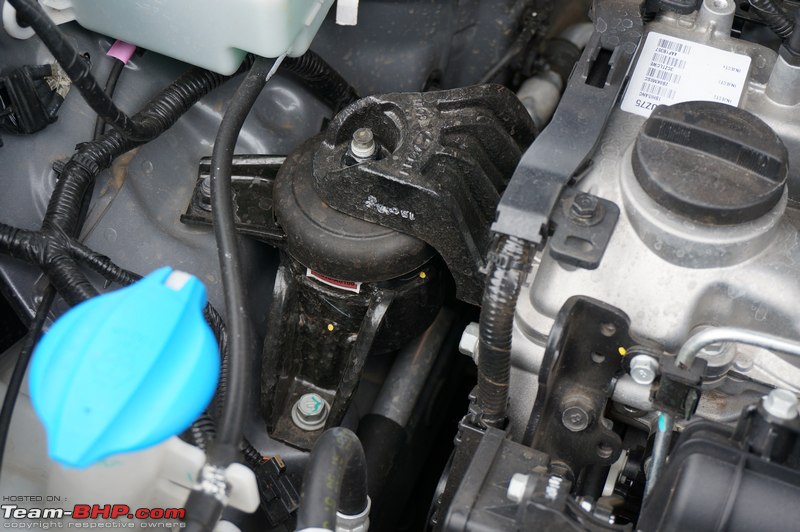 As with most Hyundai diesels, the turbocharger is bolted behind the engine:  While Hyundai has started making the 1.6L motor locally, a lot of parts are still sourced from home country:  Peep in and you'll see the vertically-mounted intercooler:  Surprisingly, no insulation sheet under the bonnet. What's even more surprising is that the diesel is still so refined!  The firewall damping:  Pull open the engine cover and you’ll see a generous amount of damping material applied underneath:  ECU sealed & placed behind the battery:  Oil filter is easily accessible. Has an element inside (not your typical metal filter). Normally, the 'O Ring' for this cover is also replaced during oil changes:  Last edited by GTO : 25th September 2015 at 14:41. Reason: Removing air plumbing pics which were incorrect. Thanks to RSR! |
| |  (42)
Thanks (42)
Thanks
 |
| The following 42 BHPians Thank moralfibre for this useful post: | Abhi99, Aditya, AkMar, Aragorn, blahman, dark.knight, fusionbang, GTO, guptashish, iliketurtles, Insearch, Jaggu, mh09ad5578, mi2n, MindOnWheels, naveen.raju, pbishayee, purohitanuj, rav11stars, RavenAvi, rednikhil, redrage, RSR, S2!!!, samabhi, scopriobharath, SDP, Sheel, sidhu_hs, Simhi, SnS_12, sourabhzen, swiftnfurious, Technocrat, theexperthand, theredliner, Tushar, vb-saan, vibbs, VijayAnand1, vikred, yosbert |
| | #7 |
| Team-BHP Support  Join Date: Dec 2004 Location: MH-12
Posts: 8,443
Thanked: 13,956 Times
| re: Review: Hyundai Creta (1st-gen) The 1.6L Petrol MT 121 BHP and 151 Nm torque on tap. Petrol is an easier fit in the engine bay than the diesel:  Hyundai's petrol engines have never been anything to write home about, hence the Creta petrol's competence left us pleasantly surprised. Though our pick would be the 1.6L CRDi, the petrol engine is quite an all-rounder, even if it won't match the diesel's fuel economy. Press the light clutch pedal, hit the engine start / stop button and the starter turns really quickly. The petrol fires up in an exceedingly refined manner. At idle, you simply won't be able to tell if it's running. The diesel motor was refined, yes, but the petrol is in another league altogether. Give this engine slightly more throttle than you would in the diesel and you get going in a seamless manner. The first thing that strikes you is the linear power delivery. It's very straight and very progressive. The engine offers good urban driveability by petrol standards. Drop the speedo to 10 - 12 kph in 2nd gear, just wait for a brief moment and it starts pulling nicely. Low rpm torque delivery is satisfactory and you'll have no problems living with it. The 1.6L certainly isn't dead at ~1,500 rpm like some other petrols. Additionally, the gear ratios are perfectly chosen. The petrol is very revv happy and easily climbs to 7,000 rpm. Hyundai petrols have indeed come a long way; remember their lame engines from the 90s? Work the Creta petrol on the open road and you can make rapid progress. It's capable of fast acceleration and thus, overtaking other vehicles poses no problem at all. However, unlike the diesel, you will need to downshift before overtaking moves. You have to work the petrol more than the diesel to access its performance envelope. The 6th gear makes the Creta petrol a capable long-distance cruiser. At 100 kph in 6th, the needle is hovering at ~2,500 rpm. At regular cruising speeds, it's so refined that you can barely hear the engine. On the flip side, the petrol makes a boomy noise at high rpms. It's not excessive, but definitely noticeable & annoying. In summary, engine to engine, Honda's 1.5L i-Vtec is the superior. But this 1.6L makes it clear that Hyundai is bridging the gap. Power is channelled via a 6-speed manual gearbox. The small shifter is smooth to use. The clutch is light enough and the throw is shorter than in the diesel. The 1.6L Dual VTVT engine:  The diesel SX(O) has a far better gear lever than this. Gosh, the petrol's gearknob is terribly basic! Not classy at all. It's smooth to operate and is matched to a light clutch:  Intake at the front and exhaust towards the firewall. Cladding has been provided underneath:  Exhaust wrapped in a heatshield:  Petrol also gets big hydraulic engine mounts. One of the reasons behind its stellar refinement levels:  You'll see stuff sourced from Korea in here:  The firewall insulation:  No insulating sheet under the bonnet:  Last edited by Aditya : 30th August 2015 at 17:24. |
| |  (39)
Thanks (39)
Thanks
 |
| The following 39 BHPians Thank moralfibre for this useful post: | Aditya, aeroamit, CrAzY dRiVeR, dark.knight, fusionbang, GTO, guptashish, heavenlybull, iabhishekkumar, InControl, Jaggu, jeetaman, mh09ad5578, MindOnWheels, Nagato710, naveen.raju, nkghai, RavenAvi, rednikhil, RSR, S2!!!, samabhi, scopriobharath, SDP, Sheel, sidhu_hs, Simhi, SnS_12, sudeepg, swiftnfurious, Technocrat, theexperthand, theredliner, Tushar, vb-saan, vibbs, VijayAnand1, yash2424, yosbert |
| | #8 |
| Team-BHP Support  Join Date: Dec 2004 Location: MH-12
Posts: 8,443
Thanked: 13,956 Times
| re: Review: Hyundai Creta (1st-gen) The Creta Diesel Automatic The diesel auto is currently available only in the SX+ trim (one level below the top-end). Rather boring grey colour - IMHO, the Creta looks best in white, silver & red:  This Diesel + Automatic combination gives Hyundai a solid differentiator over its monocoque rivals. The 1.6L CRDi engine is mated to a 6-speed torque converter AT. Good move in picking the 6-speed transmission from the Elantra, rather than the Verna's 4-speed AT. 6 ratios result in a better spread of gearing and the transmission does feel decidedly superior to the Verna's unit. However, there are no paddle shifters or a sport mode, clearly telling you this isn't an automatic (or even car) for enthusiasts. As of date, the 6-speed AT is fully imported. A light steering, soft controls, smooth automatic and clean frontal visibility make the Creta AT a breeze to drive. The properly positioned dead pedal in a spacious footwell keeps your left leg comfortable. There's a lot of room even between the dead pedal & brake pedal! The Creta AT moves off seamlessly from a standstill. Being a torque converter gearbox, that initial turbo-lag is well masked. Light accelerator input is all you'll need to commute in the city. The gearbox moves up early, while shift quality is very smooth. For bumper to bumper traffic conditions, there is a fair amount of 'crawl' available. Just lift your foot off the brake pedal in 'D' and the Creta will crawl forward at 6 - 7 kph (without any throttle input), allowing you to drive in severe traffic with only one foot. This gearbox is flawless in urban conditions. You'll see most upshifts taking place at 1,800 rpm or in the whereabouts. Prod a little harder and the gearbox upshifts at 2,500 - 3,000 rpm. Kickdown in the lower gears will see the revv counter climbing well beyond 4,500 rpm. The Creta AT offers brisk acceleration and never feels underpowered. Truth is, the punchy 1.6L diesel makes the automatic seem better than it actually is. The torque makes the engine's job easier and owners will have little to complain about. That said, the AT simply doesn't have the sense of urgency that the MT does. It's quick enough, but not as fast as the Creta MT. Thanks to the excellent engine, the Creta AT can be a competent highway cruiser too. The highway experience is calm & comfortable. When you want to overtake, the kickdown response time is around half a second before the gearbox downshifts. Par for the course, we'd say. Even on the highway, the Creta AT doesn't feel underpowered at all. However, when we wanted to overtake a 90 kph truck on the expressway, we couldn't execute the move as quickly as we'd like. If there is a fast vehicle ahead and your overtaking window is narrow, you'll have to carefully plan the move (or use 'manual mode'). While the gearbox takes half a second to react in most conditions, there are some where it'll take a full second. This 6-speed AT isn't lightning quick like the VW DSG, yet it's performance is acceptable for a torque converter unit. The gearbox is suited to calm driving, maybe even a little bit of pushing, but not an aggressive driver. Push hard with constantly changing throttle inputs and the AT can end up confused...not shifting when you want it to and vice versa. Manual mode is useful when you want to prepare the car for overtaking a fast vehicle on a 2-lane highway, or when you desire engine braking. With most automatics, you move the gearlever to the left to engage manual mode. The Creta has it inverted; you move the gearlever toward yourself, to the right. In manual mode, you can take the revv counter beyond 4,500 in the initial lot of gears. As you work your way up, the shift points come in earlier at ~4,000 rpm. The response time to your commands is reasonable. What is bothersome is that it's tuned too conservatively. For instance, there was a situation where I was asking it to downshift at 2,500 rpm and the electronics just wouldn't allow it. Honestly, most drivers will prefer to leave the gearlever in AT mode and have the electronics do all the shifting for them. What we didn't like is the AT's braking capability. Hyundai should have beefed up the braking hardware on the automatic. The brake pedal simply isn't sharp! At times, it actually feels numb as it's working against the torque being generated. While not weak, the AT's braking is overall rather uninspiring. The automatic costs around 16.50 lakhs on the road in Mumbai. You'll most definitely feel short-changed in terms of features. In such an expensive car, there's no leather cladding on the steering wheel, gear knob and handbrake lever (7 lakh hatchbacks get this). Further, the AT isn’t even available in the SX(O) trim. That means you'll lose out on the side & curtain airbags, ESP, traction control, 17" rims, leather seats and other goodies that the MT version gets. Shockingly, the AT doesn't have auto-locking doors! On the other hand, it's only the AT variant that is equipped with a 60:40 splitting rear seat and ISOFIX child seat mounts. 16” rims look small on the Creta. The AT is running Goodyear Assurance 205/65 R16 rubber. These Goodyears were louder than the 17” Bridgestones of the SX(O). Also visible in this image is the ugly rear drum - wouldn't you expect rear disc brakes at this price? Between the 16" & 17" sizes, the difference in sidewall height is merely 4 mm, hence there's no major change in ride quality:  Auto badge replaces the CRDi badge:  Nice steering, but no leather wrap. Seriously Hyundai?! No leather wrapped steering wheel in a Rs. 1.5 million car? Notice how MID controls are removed in the SX+ variant. Instead, the AT's steering wheel has the track seek buttons on the right side:  Sweet gearlever. It's short and gets a piano black finish. Unlike most other ATs, manual mode is accessed by moving the gearlever to the right (not left):  The shift lock release button. Pressing this button bypasses the gear lock system whereby you cannot move out of position "P" unless the key is inserted and the brake pedal is pressed. Use the shift lock button when you park on an incline and can’t move the lever out of "P". The feature could also be used when towing the vehicle:  Very spacious footwell:  Quite a difference between the instrument cluster of the SX(O) and lower variants. You don't get any of the settings or customisations that we showed you in the Diesel MT. The temperature & fuel gauges are positioned differently:  Being a more basic MID, it gives you readings for the driving time & average speed, along with trip A and B. You get a digital speedometer (can be turned off if you so prefer). The gearlever position is also displayed:  The eagle-eyed among you will notice that the 'missing key' warning is different in the AT:  Two dummy buttons on the lower variants (traction control off & illumination adjustment removed):  No leather inserts on the SX+ doorpad: 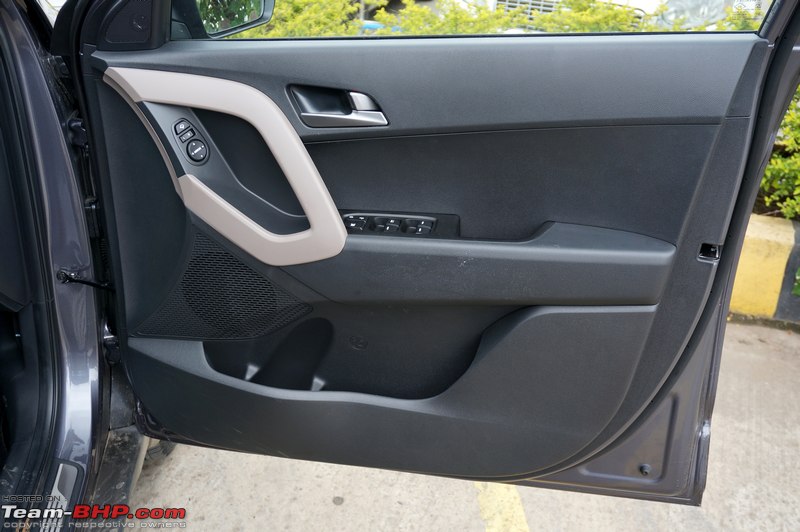 The fabric seats:  A closer look at the dual-tone fabric upholstery:  Seatbelts aren't height-adjustable on the lower trims:  The SX+ Automatic gets 3 adjustable headrests at the back, where the SX(O) only had two:  ISOFIX for child seats  : : The ISOFIX top-tether is there on both sides of the rear seat. That's a good thing if you have to carry two kids. Further, child seats take up a lot of room, so if you have a tall driver and there isn't enough space left behind him, you can place the seat on the other side:  Fixed grab handles have useful coat hooks (top variant didn't): 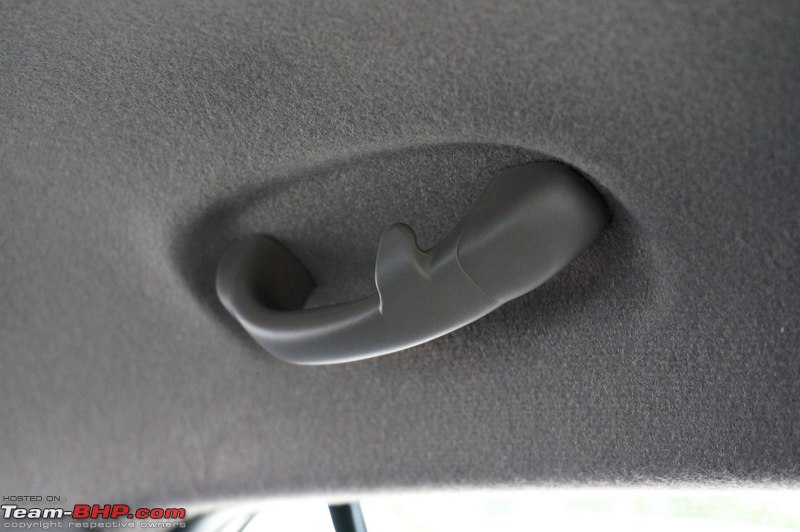 Useful boot net. All variants - other than the base - get the net:  60:40 splitting seats are only offered in the AT variant. SX(O) owners will miss out on the flexibility they bring:  Fold both sections of the seat down and they create a nearly flat bed:  Spare is a standard steel rim:  Last edited by Aditya : 30th August 2015 at 17:13. |
| |  (39)
Thanks (39)
Thanks
 |
| The following 39 BHPians Thank moralfibre for this useful post: | 9thsphinx, Aditya, AkMar, BNM, dark.knight, dkaile, ecosport rules, fusionbang, GTO, guptashish, IcarusMan, InControl, jeetaman, KPS, mh09ad5578, naveen.raju, RavenAvi, rednikhil, redrage, RSR, S2!!!, samabhi, scopriobharath, Sheel, sidhu_hs, Simhi, sourabhzen, sudeepg, sups, swiftnfurious, Technocrat, theexperthand, theredliner, Tushar, vb-saan, vibbs, VijayAnand1, Yeldo, yosbert |
| | #9 |
| Team-BHP Support  Join Date: Dec 2004 Location: MH-12
Posts: 8,443
Thanked: 13,956 Times
| re: Review: Hyundai Creta (1st-gen) Other Points: • To know what an EcoSport owner thought of the Creta, click here. • To know what a Yeti owner thought of the Creta, click here and here. • Service intervals of 10,000 kms / 1 year. • Euro-style dual tone horn sounds awesome. It's what you'd expect to find in a German car. • Available with 7 colour options - Polar White, Sleek Silver, Pearl Beige, Stardust, Mystic Blue, Red Passion and Phantom Black. • Hyundai offers the Creta with a 3 year / unlimited kilometres warranty, extendable by a further 2 years. As if to go one up on Toyota which offers a 3 year / 100,000 kms standard warranty with no extendable option. • Most variants already have a 3 month waiting period. Some (like the diesel automatic) go over 6 months in some cities. The existing factory is running at full steam. Media reports state that Hyundai is investing Rs. 5,000 crore in a new plant to boost production capacity. To keep up with local & export demand (including upcoming products), Hyundai is going to need that additional capacity. • The 1.6L diesel & AT are 'India-only' offerings. Period. The rear a/c too is only seen on the Indian Creta. • We're willing to bet that the % of female customers for the Creta will be a lot higher than for competitors like the Duster & XUV500. This is because of its lighter controls (including the clutch), friendlier ergonomics, size & styling, fit & finish, AT gearbox and the Hyundai brand. • According to research presented by Hyundai, global SUV market-share has gone up from 14% in 2010 to 21% in 2014 (vis a vis other body styles). Design is the top buying criteria for SUVs (46% of respondents rated styling as the highest influencing factor). • Hyundai put the Creta through 2.5 lakh kms of testing before its launch. • The Creta has a smart alternator management system (AMS). Basically, the system disengages the alternator during acceleration (thus, all engine power is used for accelerating only). During deceleration and idling is when the alternator charges the battery. • The Creta has a 'battery saver' feature to prevent flat batteries. If you switch off the car with the headlamps & foglamps on, the system automatically turns them off. • Whenever a new SUV is launched, you can bet that topples will follow. We saw that with the EcoSport, and we see it with the Creta. People need to understand that SUVs handle differently than sedans. Related link. • Impact sensing door-unlocking system, but only in the top 4 variants. This basically unlocks the doors in a crash, allowing passengers to get out & rescuers to get in. • Like other cars, the indicator stalk has a lane change function. Tap lightly to make it flash thrice. In the SX (O), you'll find a setting to increase this frequency to 5 or 7 blinks! • The Creta has a cluster ionizer. Hyundai says that it generates ions to purify and deodorize air inside the cabin. • The automatic climate control will always start in fresh air mode. It won't remember your recirculation setting. On the other hand, push the air-con knob (manual mode) and it remembers your recirculation setting. • The rear defogger has a timer. Even if you forget to switch it off, the defogger will automatically deactivate after a little time, to prevent any heat damage to the rear windscreen. • The smartkey sensor is very sensitive & accurate. Even if you are leaning against the driver's door (outside) with the smartkey in your pocket, it will give you the missing key warning. If you walk out of the car with the smartkey and the engine is running, you'll hear a loud warning beep on the outside. • As long as the key is in your pocket, walk up to the boot, press the electromagnetic strip under the chrome garnish and the boot will open. No separate 'boot release' button inside the cabin. The tail-gate is linked to the car's central locking system. • The power windows will function for a little time after you switch off the engine. Why? To give you time to roll up any windows that were left open. Open the driver's door and the system deactivates. • Fuel tank capacity = 55 liters. • ARAI fuel economy figures are as follows. 1.4L diesel (21.38 km/l), 1.6L diesel MT (19.67 km/l), 1.6L diesel AT (17.01 km/l) and 1.6L petrol (15.29 km/l). • Say you switch the car off while streaming Bluetooth audio. When you start the car again, the audio system always begins with the radio on. And no, you can't just press a button and resume the Bluetooth audio. You have to first agree to the terms & conditions on the touchscreen, then press the media button, and choose Bluetooth audio from there. Too many steps! • This must be the only ICE head-unit without a built-in clock! What you get is a separate digital clock placed right above the HU. • Navigation data is stored onboard, and not on an SD card. • We had marked a house on the navigation system. Two days later, when we were about 200 meters away from that place, the navigation system tells us "around the marked point", even though we didn't have any maps running. • The lower variant's touchscreen HU (without navigation) gets 1 GB of onboard storage for a couple of hundred MP3s. • Great times for SUV customers - how the segment has exploded! Before the XUV500 (2011) and Duster (2012) were launched, your options were largely limited to the Scorpio & Safari. • Remember Ford's pull-drift compensation? Hyundai mentioned that the VSM (ESP) can make the steering correct unintended vehicle pull in one direction. The ESP will apply counter-steering input when necessary. We expect it to be a very mild action though, and something that the driver can easily overpower (if he so wishes). On international websites, this steering correction is reported to have a max force of merely 8 Nm. • Disclaimer: Hyundai invited Team-BHP for the Creta test-drive. They covered the accommodation expenses for this driving event. Last edited by Aditya : 30th August 2015 at 10:42. |
| |  (43)
Thanks (43)
Thanks
 |
| The following 43 BHPians Thank moralfibre for this useful post: | Aditya, AkMar, Aragorn, Behemoth, BNM, Chrome6Boy, CrAzY dRiVeR, dkaile, groom, GTO, jeetaman, KPS, manoj_joseph78, mh09ad5578, Michael_Fanai, MindOnWheels, naveen.raju, noopster, pbishayee, RavenAvi, rednikhil, RSR, S2!!!, samabhi, scopriobharath, SDP, Sheel, sidhu_hs, SnS_12, sudeepg, swiftnfurious, Technocrat, The Rationalist, theexperthand, theredliner, tjacob, Tushar, vb-saan, vibbs, VijayAnand1, vikred, yosbert, zing |
| | #10 |
| Team-BHP Support  Join Date: Dec 2004 Location: MH-12
Posts: 8,443
Thanked: 13,956 Times
| re: Review: Hyundai Creta (1st-gen) The Smaller yet Significant Things: The underbody cladding. It's a good thing that no critical components are left exposed, although my first choice would be metal guards (instead of this plastic). Get a better look at the underbody in this image  : : XL-sized exhaust can mounted horizontally. There aren't any low hanging bits and everything is tucked in properly:  Fuel tank placed ahead of the axle:  The bump stopper in a prominent orange:  Fuse box & OBD port are located right above the driver's footwell. Master 'On / Off' switch is unique. In 'off' position, it will automatically cut off current leakage from the battery. Can be useful for the times that you want to park the Creta for a longer duration:  Triple insulation! Two layers on the door and one on the frame:  Subtle mods can greatly enhance the looks. Here is BHPian BNM's sexy red Creta with a black roof & aftermarket rims:  Zooming in on the perforated seat & contrasting white stitches:  Mismatched features within the model range! The Rs. 6 lakh Grand i10 gets a request sensor on the passenger-side door. Not so on the Creta SX(O) which costs nearly thrice as much:  The backside of the control stalk. This is what we were talking about - the toggle switch can also be operated from the back:  A system check when you start the Creta:  Attention to detail! When you shut the errant door, the MID mimics the door's closing action:  190 mm of ground clearance is enough to clear rough roads & Bangalore's skyscraper speed-breakers. We once took an unofficial exit from the highway onto a service road; she didn't scrape on that brutal slope:  Tweeters mounted on the door, next to the A-Pillar:  Cladding between the steering & instrument console to cover up the ugly gap:  Screw-in tow eye at the front & rear:  It's all in the family! Mobis is the parts arm of Hyundai. Carpet mats imported from Korea:  Among the nicest hooks we've seen to hold floor mats in place:  At the press drive event was this Creta parked in a camping setup. Not without AWD, you aren't (going camping):  Foldable hooks for the boot net can be tucked away when not in use:  VIN stamped below the driver's seat:  Brand welcome when you get to the car:  Activate / deactivate the child lock (rear doors) with a key or screwdriver:  Last edited by Aditya : 30th November 2015 at 13:15. |
| |  (40)
Thanks (40)
Thanks
 |
| The following 40 BHPians Thank moralfibre for this useful post: | 9thsphinx, Abhi99, Aditya, aeroamit, Ahmed, AkMar, bblost, blahman, BNM, CrAzY dRiVeR, dark.knight, fusionbang, GTO, guptashish, jeetaman, manoj_joseph78, mh09ad5578, naveen.raju, nkghai, pbishayee, RavenAvi, rednikhil, RSR, S2!!!, samabhi, scopriobharath, SDP, Sheel, sidhu_hs, Simhi, SnS_12, sudeepg, swiftnfurious, Technocrat, theexperthand, theredliner, Tushar, vb-saan, VijayAnand1, yosbert |
| | #11 |
| Team-BHP Support  Join Date: Dec 2004 Location: MH-12
Posts: 8,443
Thanked: 13,956 Times
| re: Review: Hyundai Creta (1st-gen) What you’ll like: • A monocoque SUV at the price of C2 segment sedans. Good looking too • Robust, abuse-friendly build & construction. Capable AWD available • Outstanding ride quality. Comfortable over any kind of road • Car-like to drive. Balanced handling and dynamics • 205 mm of ground clearance. Dismisses broken roads with aplomb • Fuel efficient 1.5L diesel engine with adequate power on tap • Practical boot (475 - 1,064 liters of cargo capacity) What you won’t: • No 3rd row of seats. A 5 seater SUV, unlike its 7 seater competitors • Cost cutting glaringly evident on the inside. Weird ergonomics as well • Mediocre rear seat legroom. More like C1 segment sedans than C2 • 109 BHP diesel has noticeable turbo lag below 2,000 rpm (not in the AWD) • Higher variants are steeply priced. 110 PS Duster is too close to the XUV500 • No climate control, 60:40 split on rear seat, dead pedal, auto locking doors or 1-touch down windows • Renault's after-sales is a hit or miss What you’ll like: • A well-engineered, contemporary SUV with a value-for-money price tag • More mature styling. Front end no longer looks garish • Acres of space on the 1st & 2nd seat rows • Competent engine delivers fantastic urban driveability, as well as fast highway performance • Balanced ride & handling package • Safety kit includes 6 airbags, ESP with rollover mitigation, ABS + EBD and all-wheel disc brakes • Expansive feature list (sunroof, touchscreen ICE, powered driver's seat, cruise control etc.) What you won’t: • Absolutely no luggage capacity with all the seats in place • Cramped 3rd seat row is best suited to children only. A sliding middle row is sorely missed • Interior quality, although better, still has a lot of scope for improvement • Clutch is lighter now, but has a long travel range & high resting point. Gets cumbersome in traffic • Niggles & issues, as reported by existing XUV500 owners • Mahindra's inconsistent sales & service experiences • Automatic transmission nowhere in sight. Premium customers love their ATs What you'll like: • Snazzy, futuristic styling makes the EcoSport a head-turner. Solid construction too • 3 engine options, including the impressive 1.0L EcoBoost & economical 1.5L Diesel • Loaded to the gills with technology & equipment (SYNC, cooled glovebox, leather seats, parking display...) • Smartly packaged interior. Adequate space for 4 adults. Lots of storage and practical features • Dynamically sorted. Competent handling by SUV standards • City-friendly! Great ergonomics, driving position, manoeuvrability and size for urban India • Safety kit includes 6 Airbags, ABS + EBD, Emergency assistance phone call, Emergency brake warning etc. AT variant gets ESP and Hill-Hold What you won't: • Hyundai-esque light electric steering on the Highway • Ride quality isn't as plush as that of the Renault Duster. Underlying stiffness obvious • 362 liter boot is significantly smaller than all competitors • Narrow cabin width makes a 5th occupant unwelcome. Best for 4 onboard • Sub-4 meter size and compact dimensions take street cred away • Tree trunk thick A-Pillars result in severe blind spots • EcoBoost only on top variant. No high-powered diesel like the Duster 110 PS What you'll like: • Same popular SUV package, now improved in the 2014 avatar • Robust, abuse-friendly build & construction • Aggressive front-end styling. Has good street presence • mHawk turbo diesel is a jewel of an engine. Great driveability, performance & fuel economy • New chassis brings better road manners • 4x4 available on S4 variant too. More affordable than the Safari 4x4 & Duster AWD • The Scorpio enjoys strong resale value in the used car market • Features: 6" touchscreen system, GPS navigation, projector headlamps, LED tail-lamps, auto-headlamps & wipers, cruise control, 17" rims etc. What you won't: • Ride quality, though improved, is far from plush. Still gets bouncy & bumpy • Surprisingly limited 2nd-row legroom in an SUV of this size • Overdone rear end styling. Also, decade-old body shell shows its age • Fit & finish leave a lot to be desired. Rough edges are plentiful • Price of the higher variants is dangerously close to the more accomplished XUV500 • Niggles & issues, as reported by existing Scorpio owners • Mahindra's after-sales service quality is a hit or miss. Remains a gamble What you’ll like: • The best Safari till date. Tata continually upgrades & tweaks this SUV • Solid body-on-frame construction. Substantial size & strong presence • Competent 148 BHP engine. Excellent driveability & superb refinement • Improved interiors, comfortable driving position & a much lighter clutch • 1st & 2nd seat rows have enormous space. Nice seats too • Good ride quality. Also, the X2 chassis brings better road manners & braking ability • Low range 4x4 transfer case, limited slip differential and sufficient rear wheel articulation • Additions such as a bigger 63 liter fuel tank, steering-mounted audio controls, double-din ICE, flippy key & LED cabin lamps What you won’t: • The same old body style. Surely shows its age • Effectively a 5 seater. The 3rd row jump seats aren't suitable even for kids • Not as dynamically accomplished as the XUV500, Duster or its sibling, the Aria • No MID, navigation, climate control, reversing camera or dead pedal in a Rs. 15 lakh car • ABS & all-wheel disc brakes removed from the base LX variant • Niggling issues & problems (as per the many Safari ownership reports) • Tata's after-sales service experience remains a gamble • 4x4's critical electronic bits & fuel tank are placed too low. No protective plate against splashes either. Massive size & kerb weight negatively affect its offroad performance Last edited by Aditya : 30th August 2015 at 09:13. |
| |  (51)
Thanks (51)
Thanks
 |
| The following 51 BHPians Thank moralfibre for this useful post: | Aditya, aeroamit, ampere, Aragorn, asingh1977, bonnyhere, brohanv, Chrome6Boy, Contrapunto, gotovamsee, GTO, guptashish, hybridpetrol, jeetaman, landcruiser123, mallumowgli, MindOnWheels, naveen.raju, RavenAvi, rednikhil, RoadSurfer, RSR, S2!!!, samabhi, satan's_valet, sbala, sbalagru6, scopriobharath, SDP, Sheel, shreyak_ss, sidhu_hs, Simhi, SnS_12, sourabhzen, sudeepg, The Rationalist, theexperthand, theredliner, Turbo_asd, Tushar, vaasu, vasoo, vb-saan, vibbs, Vid6639, VijayAnand1, vijay_rodie, vinitbhavi, yajaman99, yosbert |
| |
| | #12 |
| Team-BHP Support  | re: Review: Hyundai Creta (1st-gen) Thread moved from the Assembly Line to Official Reviews. Thank you, Moralfibre! The Creta impresses in many ways, and is disappointing mainly on the features list. Who would've thought we'd be complaining about equipment in a Hyundai?! Nevertheless, it's currently got the best brand in the segment and is the 'safest' choice for customers who want the 'look' of an SUV with the 'drive' of a sedan. Very well-rounded product with no real deal-breaker. In many ways, the Creta is to the 15 lakh SUV segment what the Honda City is to the C2 sedan segment = Both are 'can't go wrong' choices. I'm going to go against the tide and repeat what I said in the earlier thread = Nope, I don't think the Creta is overpriced. It's worth every rupee of the premium over the Duster. I usually buy only the top-end variant of cars & comparing the SX(O) to the Duster RxZ, the Hyundai gives me 4 additional airbags, a lot more equipment, quality, refinement, sound ergonomics, superior after-sales and contemporariness. Totally worth the 1.xx lakh premium. If anything, I would say that the 15 year old Scorpio & 2-decade old Safari Storme are overpriced!! Equally, I might add, the Creta isn't my kind of car at all. If I were looking for an SUV in this segment, I'd put my money on the XUV500 AWD. I remain a big fan of the XUV500, and Mahindra has continually improved it over the years. Last edited by GTO : 23rd August 2015 at 15:50. |
| |  (61)
Thanks (61)
Thanks
 |
| The following 61 BHPians Thank GTO for this useful post: | Abhi99, aeroamit, ampere, Behemoth, BNM, BoneCollector, brohanv, Chrome6Boy, Contrapunto, DrANTO, gotovamsee, gpa, harry10, hybridpetrol, Indian, kevintomin, KPS, Mahesh Prasad, mh09ad5578, mi2n, moralfibre, naveen.raju, nitinmurali, nkghai, pachchu77, PearlJam, pgginish, RavenAvi, rednikhil, revved_up, RJ2285, RSR, S2!!!, Safari_Beast, samabhi, satan's_valet, sbala, scopriobharath, SDP, Sheel, Simhi, Sisu, SnS_12, sourabhzen, sudeepg, swiftnfurious, Technocrat, The Rationalist, theredliner, tjacob, TrailBlazer007, Turbo_asd, vaasu, vasoo, vb-saan, vibbs, Vid6639, VijayAnand1, vijay_rodie, vinitbhavi, Vitalstatistiks |
| | #13 |
| BHPian Join Date: May 2015 Location: Mumbai
Posts: 136
Thanked: 197 Times
| re: Review: Hyundai Creta (1st-gen) Thank you for the wonderful and exhaustive review. Talking about the missing features, speed sensing auto locks in another one that is sorely missed. I believe, the lock signal to all doors beyond a certain speed is all what is needed. This shouldnt require any additional hardware (i suppose). This is a very basic feature which almost all cars has, in a segment much lower. I would really like to understand the thought process of Hyundai on skipping this feature across all models but SX(O). |
| |  (4)
Thanks (4)
Thanks
 |
| The following 4 BHPians Thank Abhi99 for this useful post: | GTO, moralfibre, RavenAvi, RSR |
| | #14 |
| BHPian | re: Review: Hyundai Creta (1st-gen) Good review. Don't think the Creta is overpriced, however when you hear that Verna 4S has a discount of 81k, Duster a discount of 70k, it does seem a little pricey. Nevertheless, any review of the 1.4 diesel? |
| |  (2)
Thanks (2)
Thanks
 |
| The following 2 BHPians Thank gauravdgr8 for this useful post: | Abhi99, Karthik Chandra |
| | #15 |
| BHPian Join Date: Mar 2015 Location: HP/33
Posts: 294
Thanked: 960 Times
| re: Review: Hyundai Creta (1st-gen) Finally the most awaited review is here. And guess what? It was worth the wait. The rear end seems to be the weak link in the entire package. As already said plenty of times earlier, the premium pricing might be a deterrent for some but a 6 month waiting shows Hyundai's greed for more profits has worked. |
| |  (1)
Thanks (1)
Thanks
 |
| The following BHPian Thanks MSC for this useful post: | moralfibre |
 |



